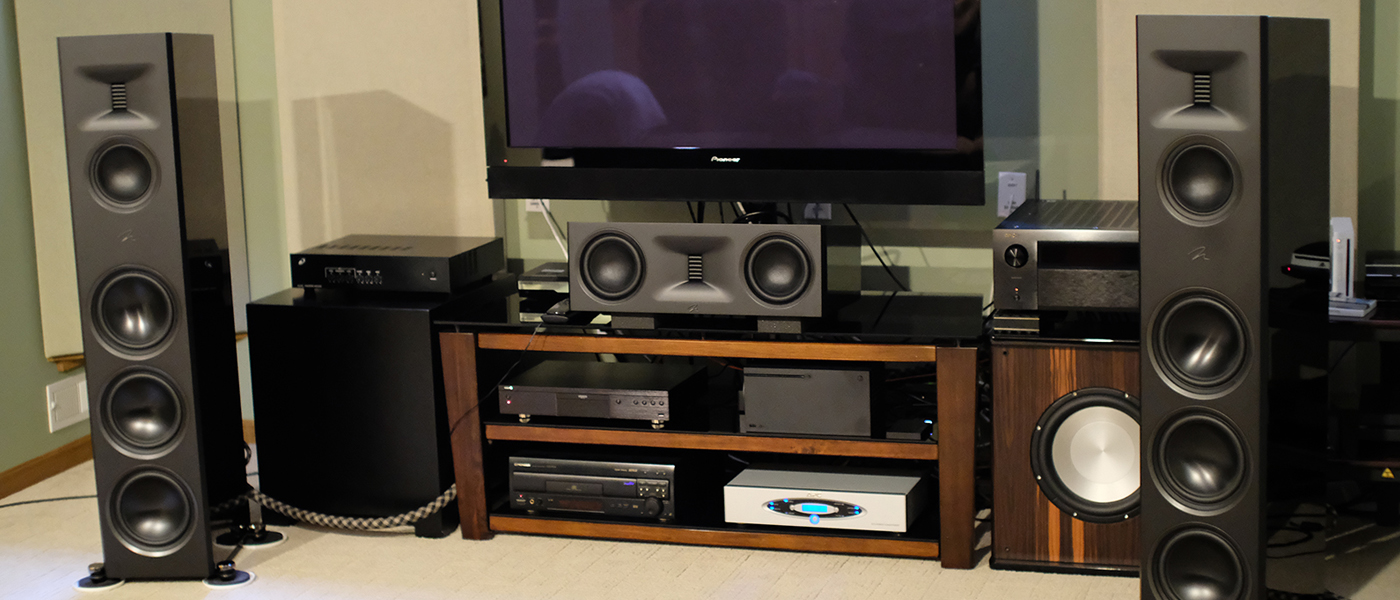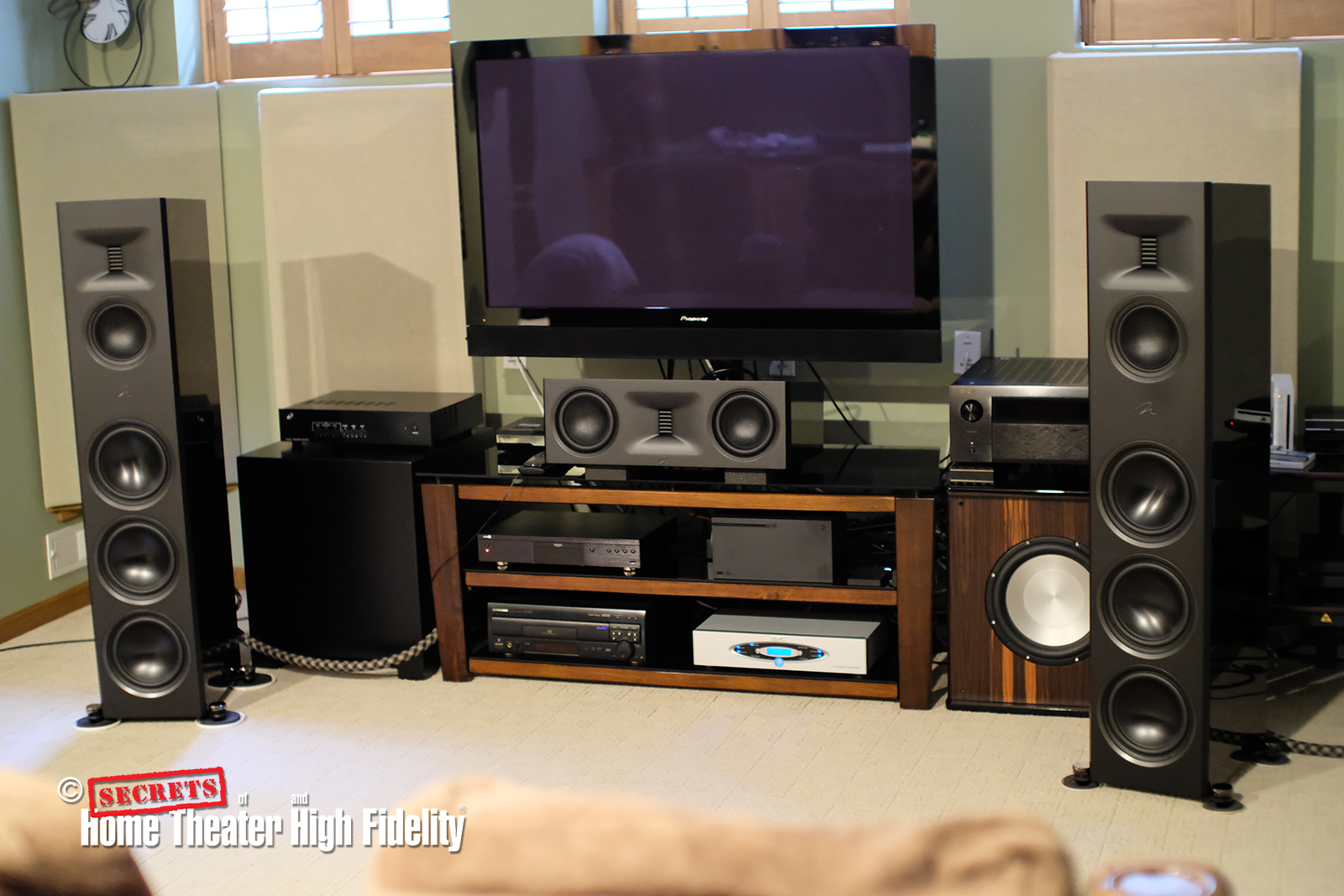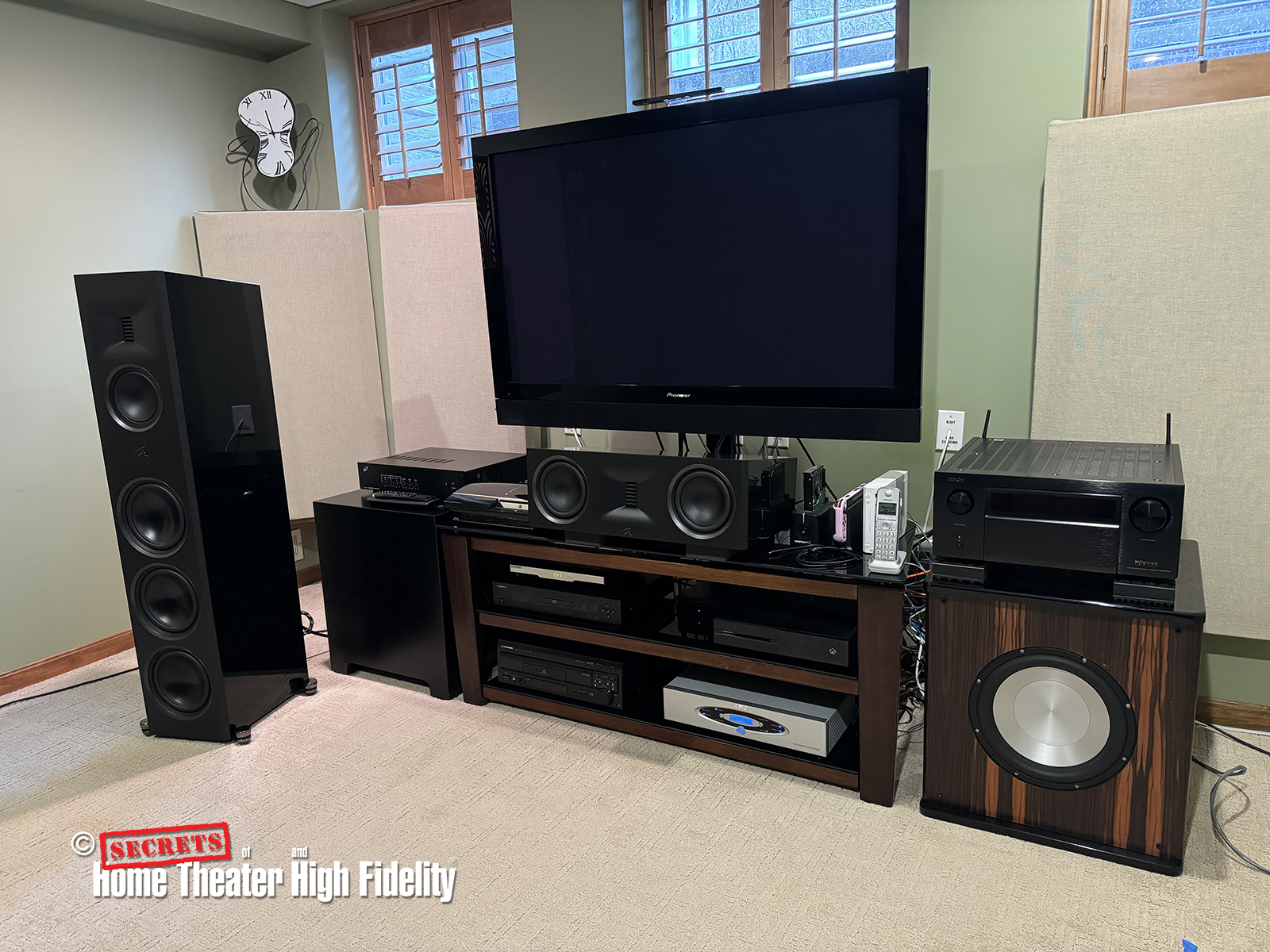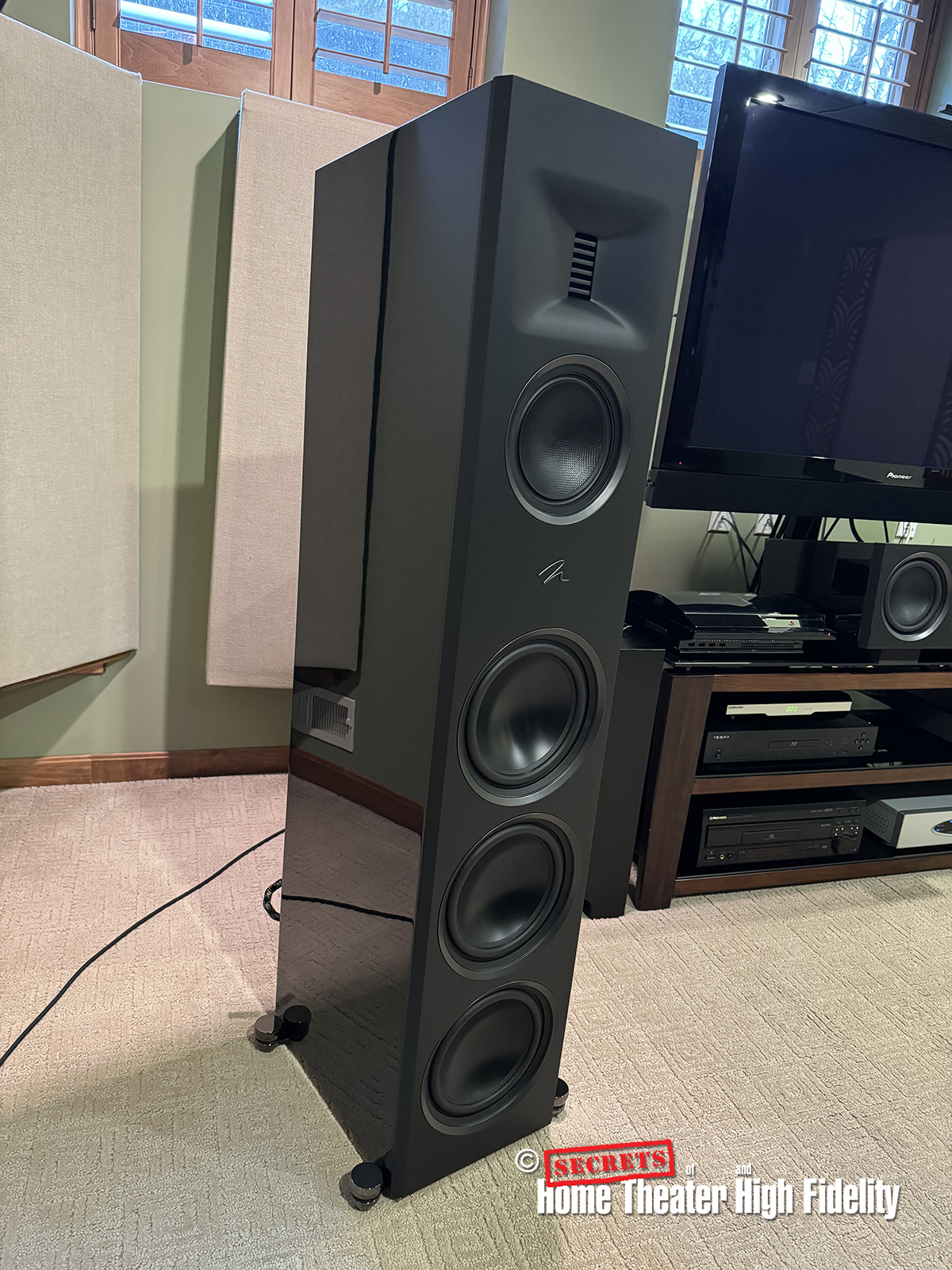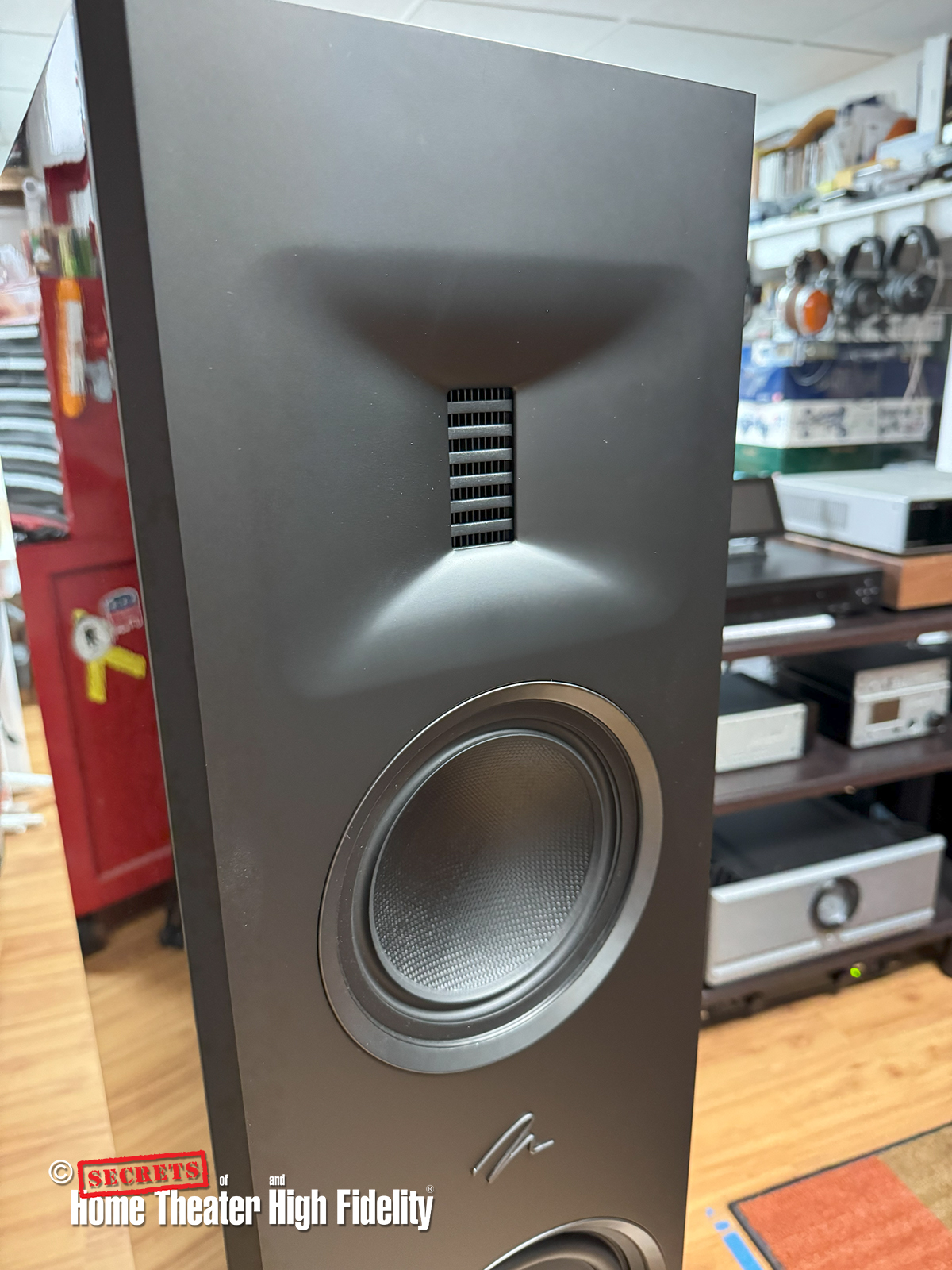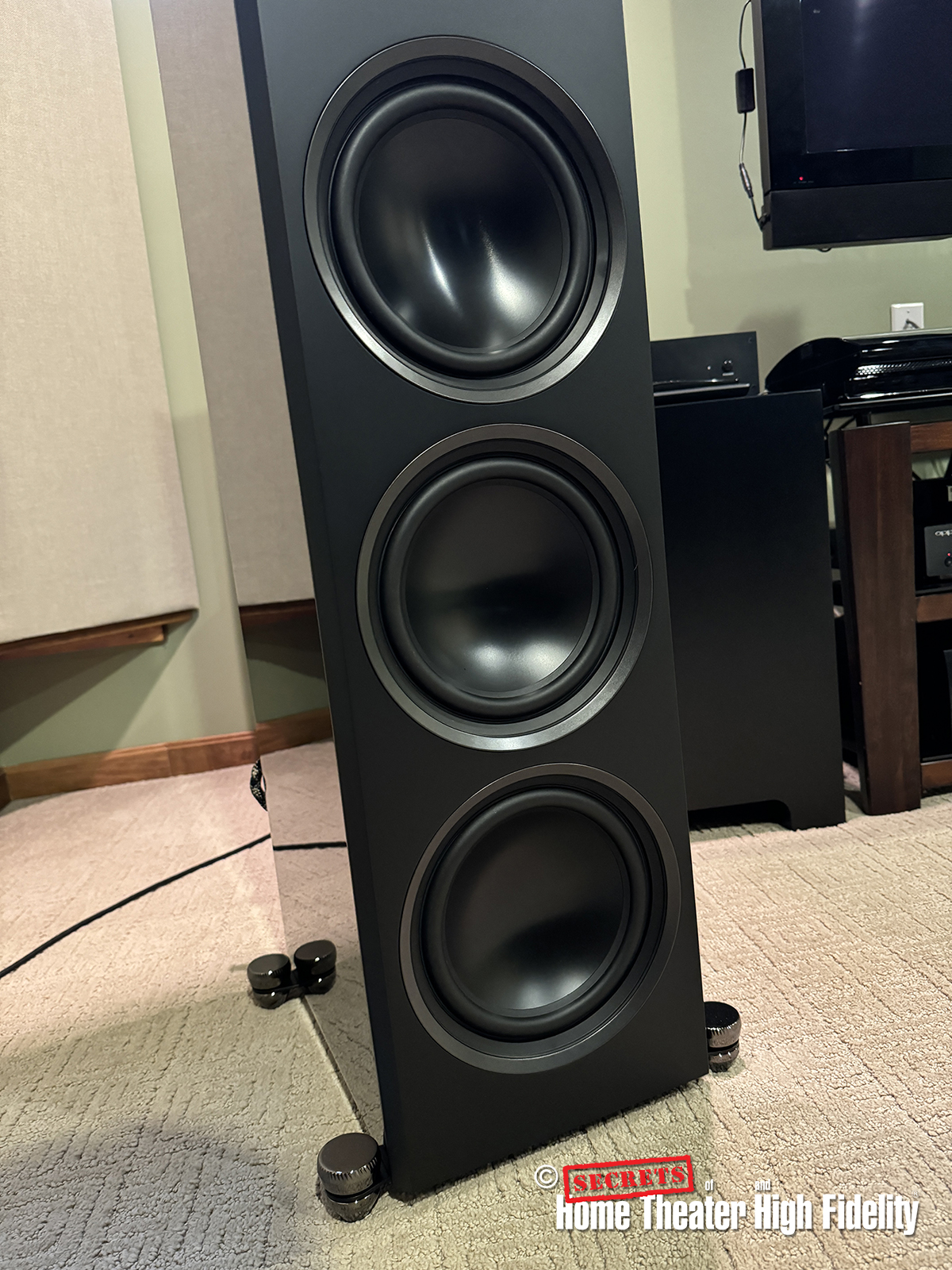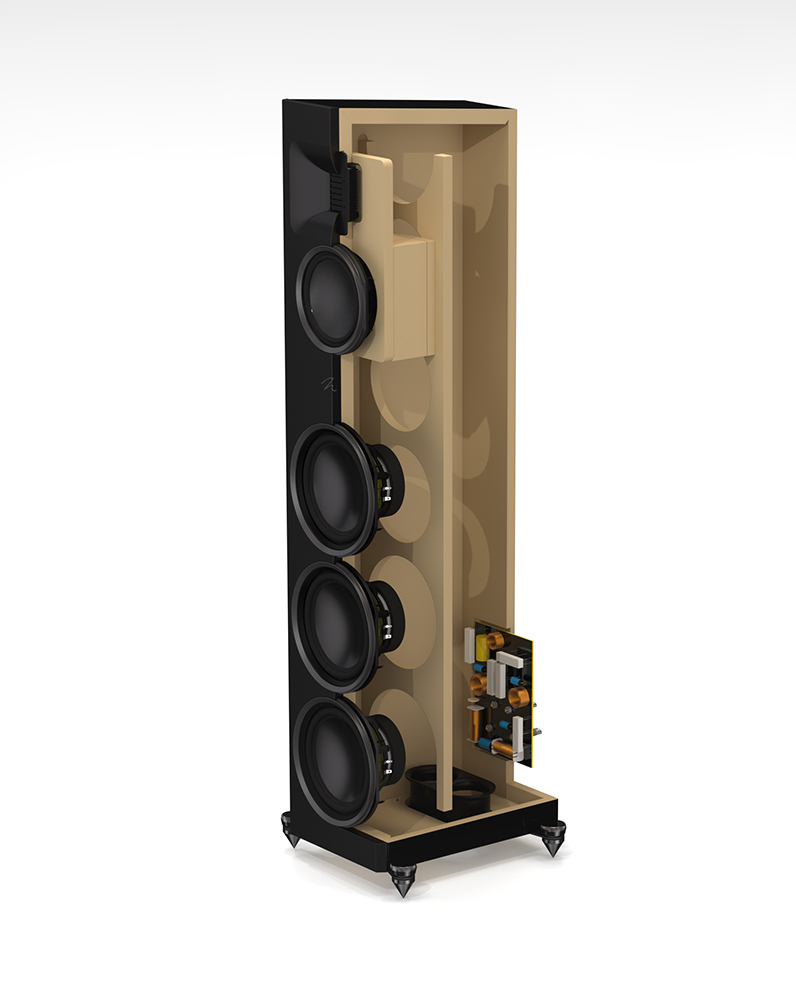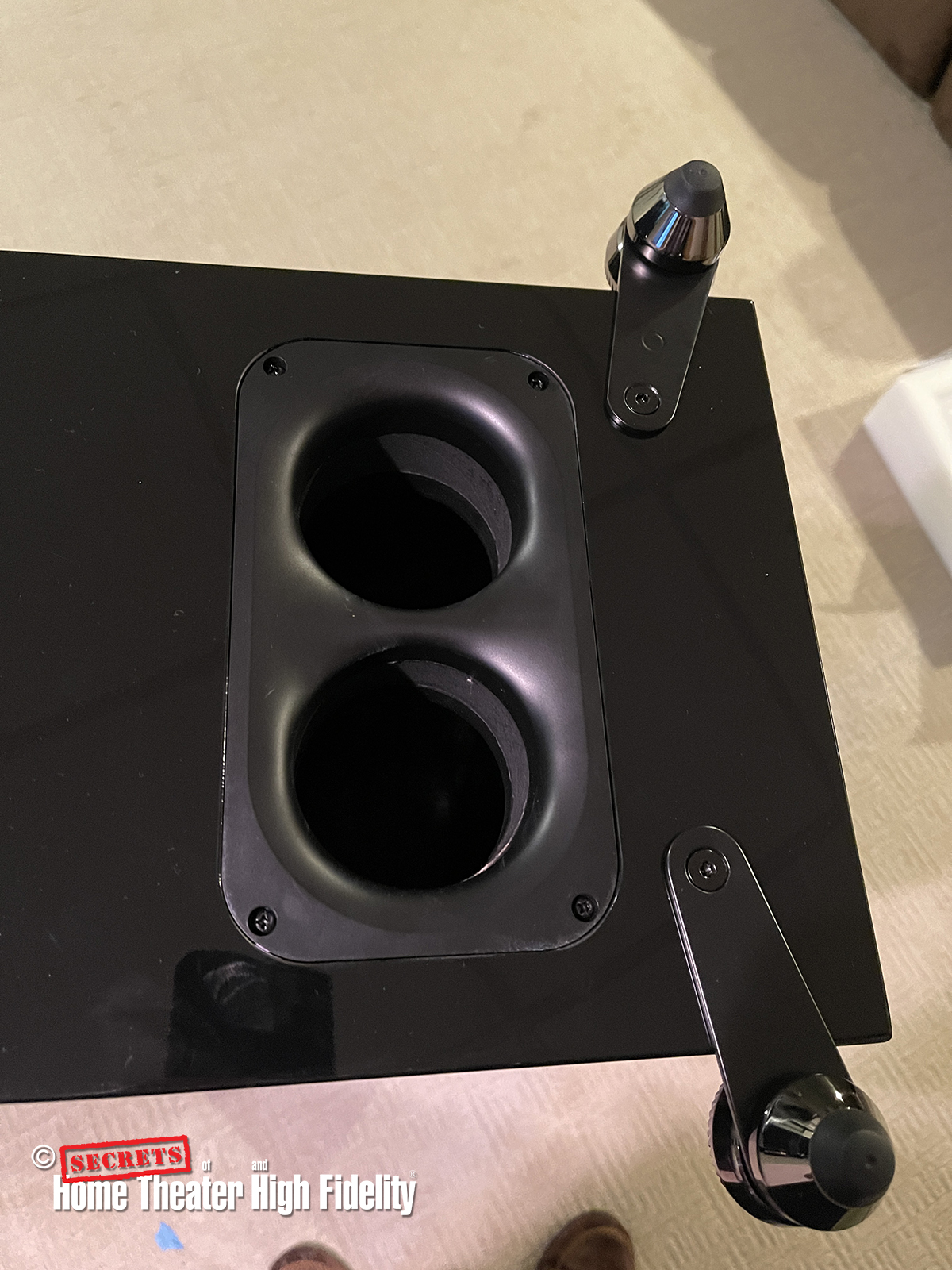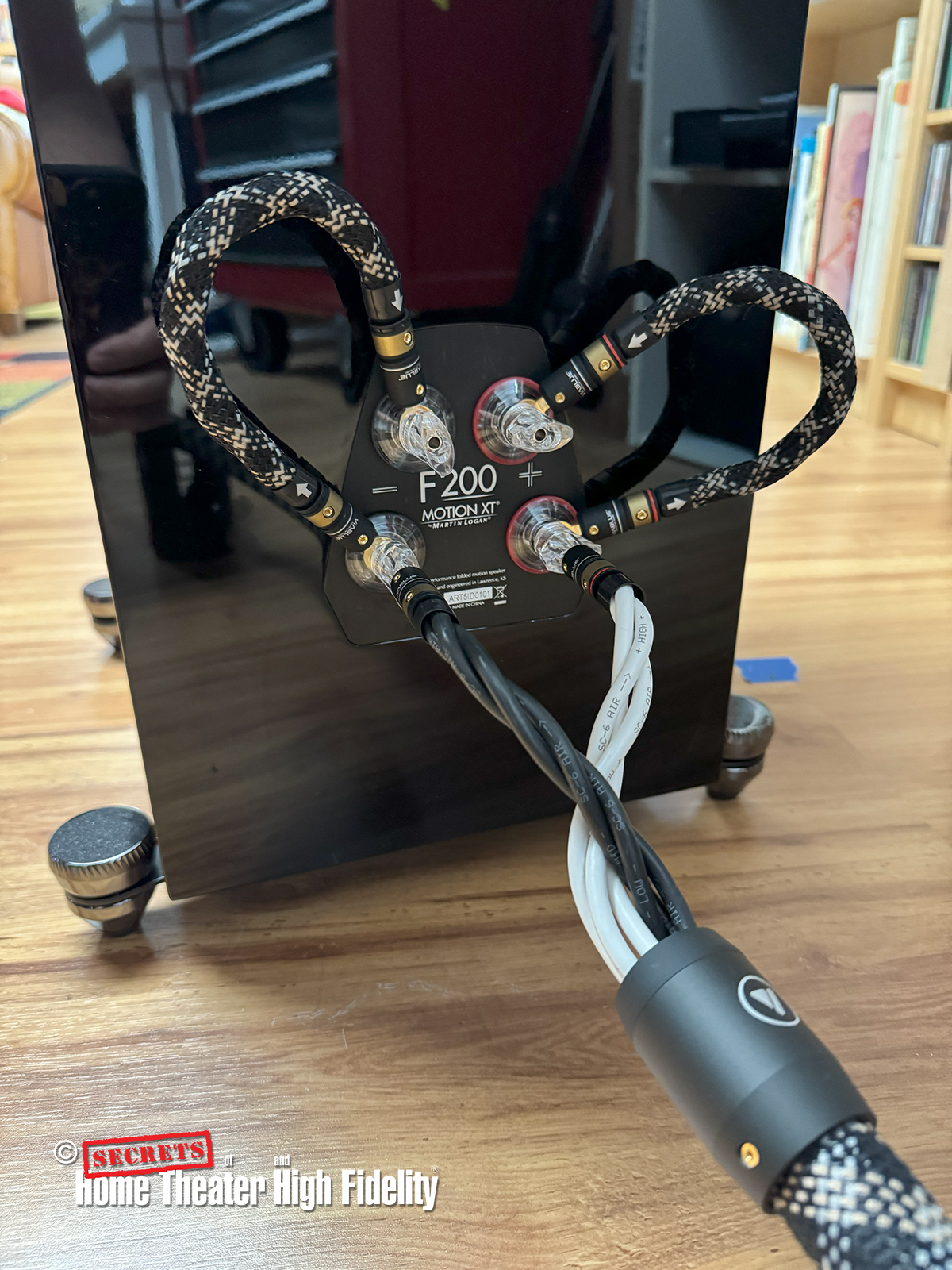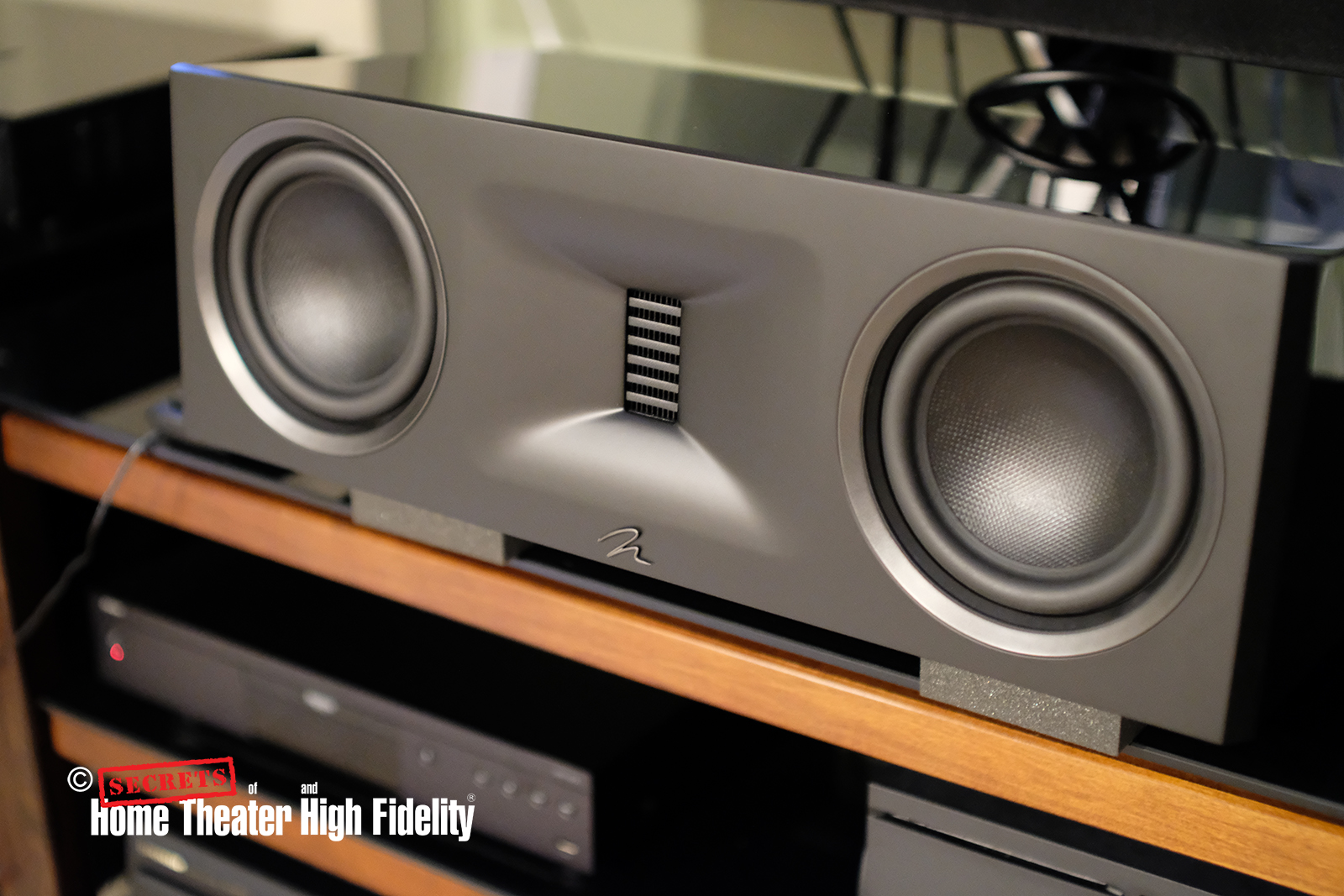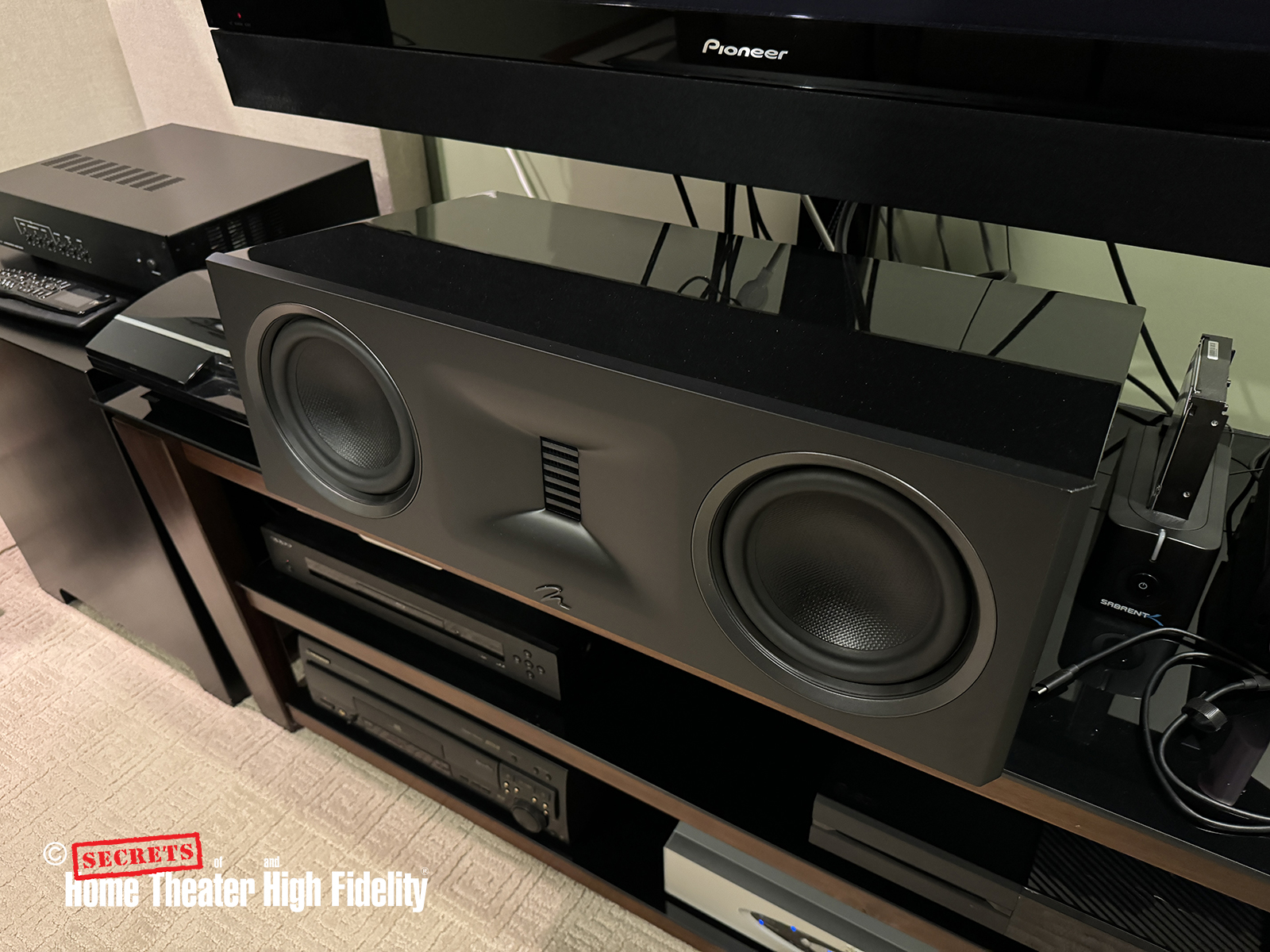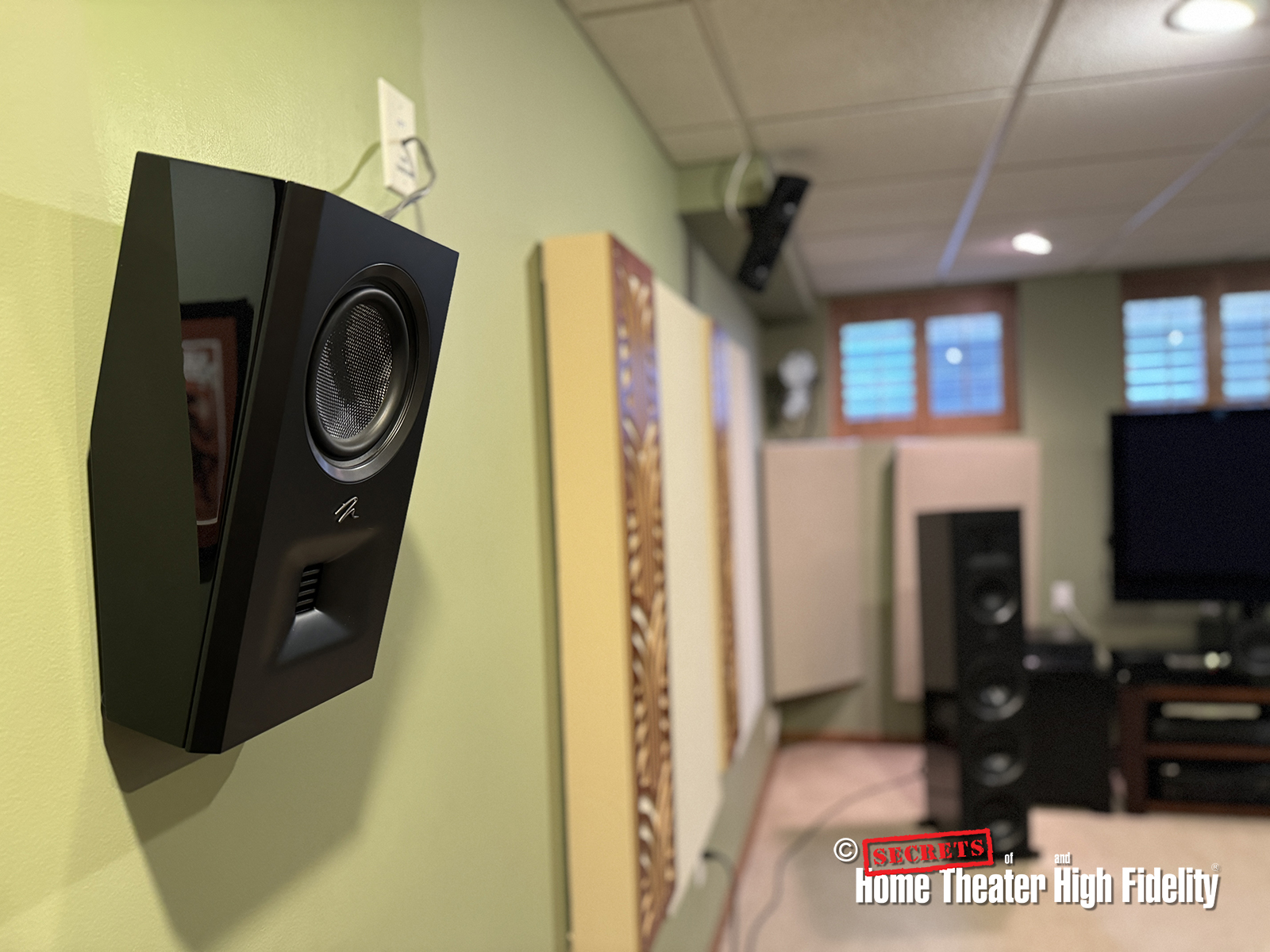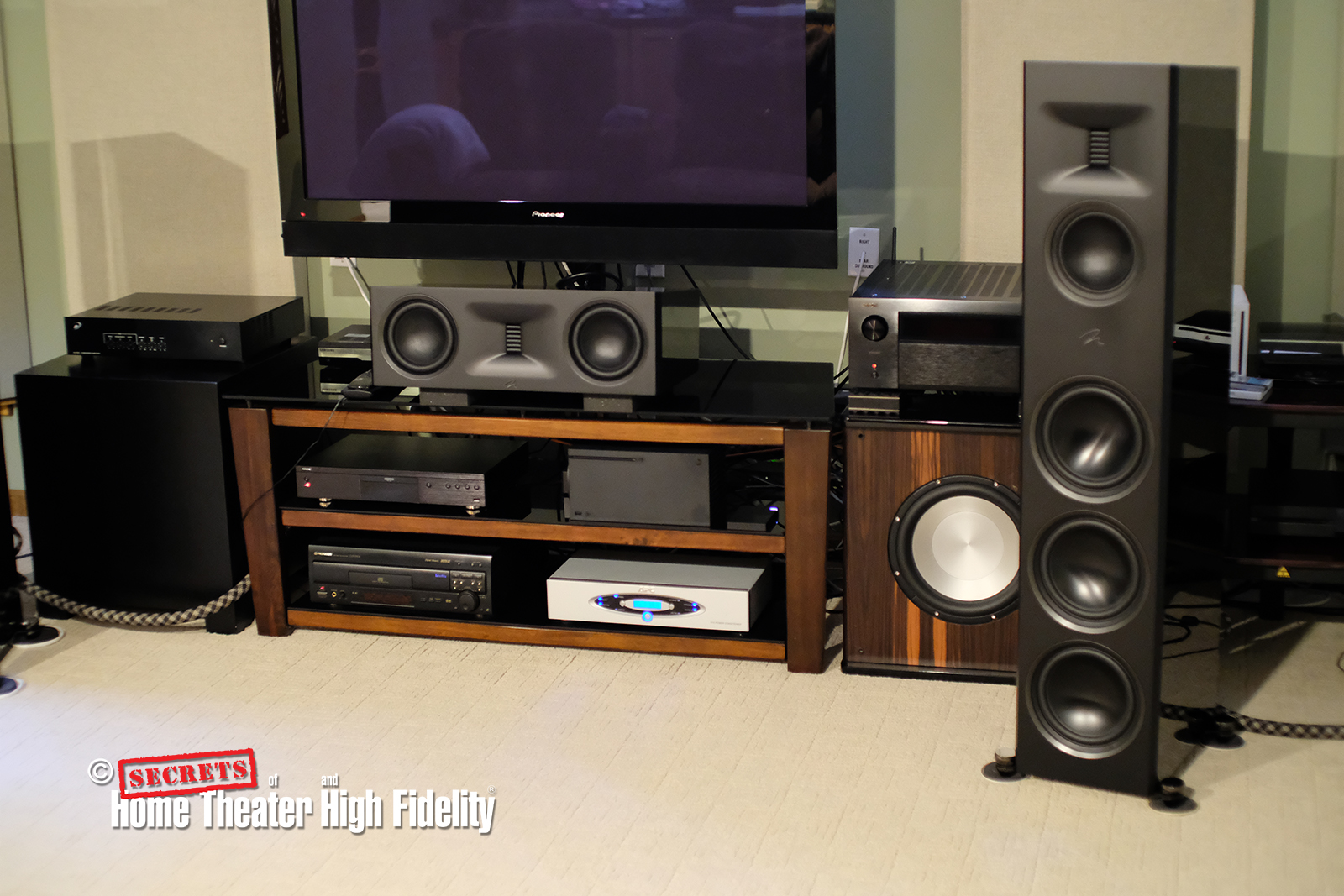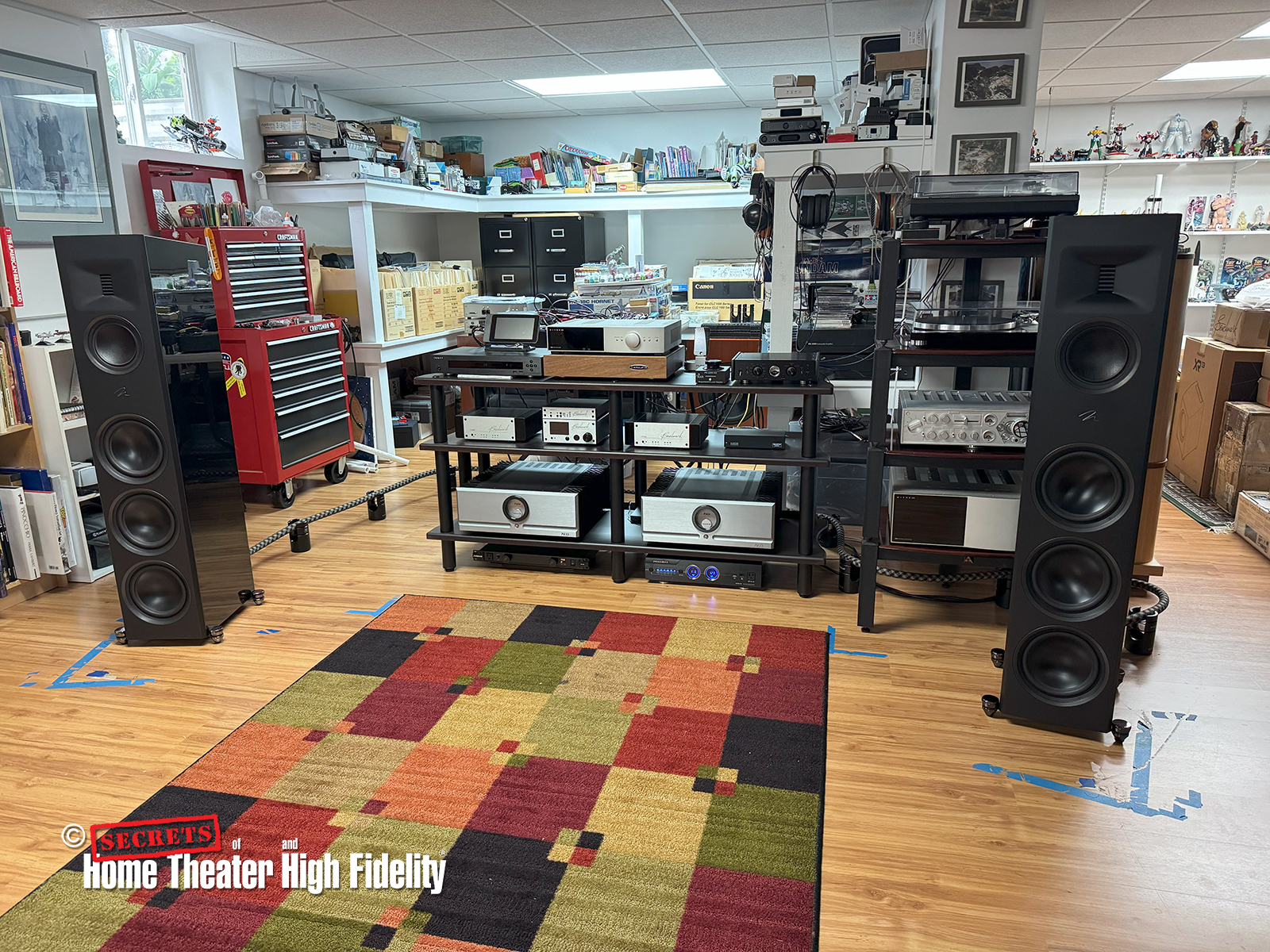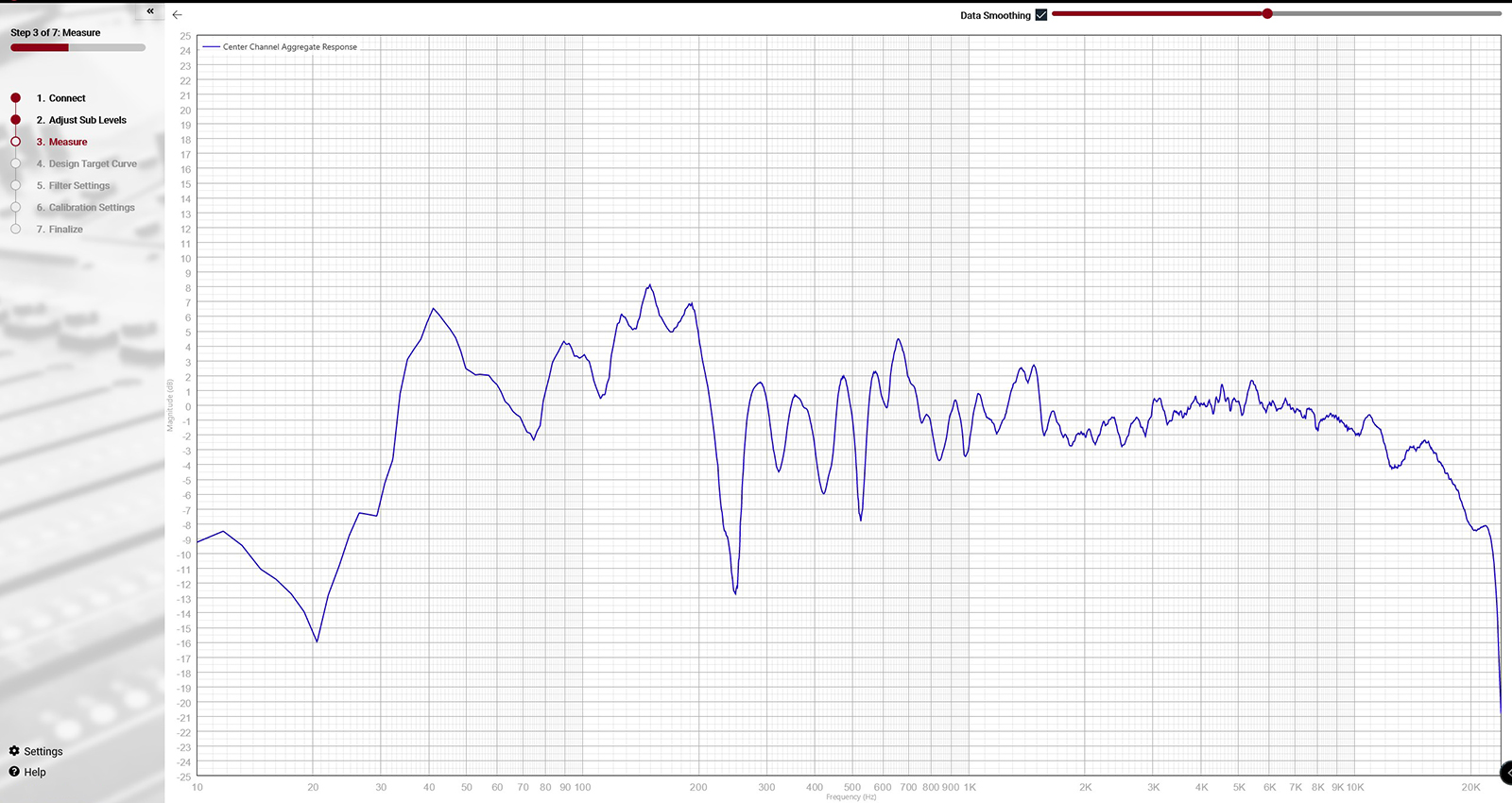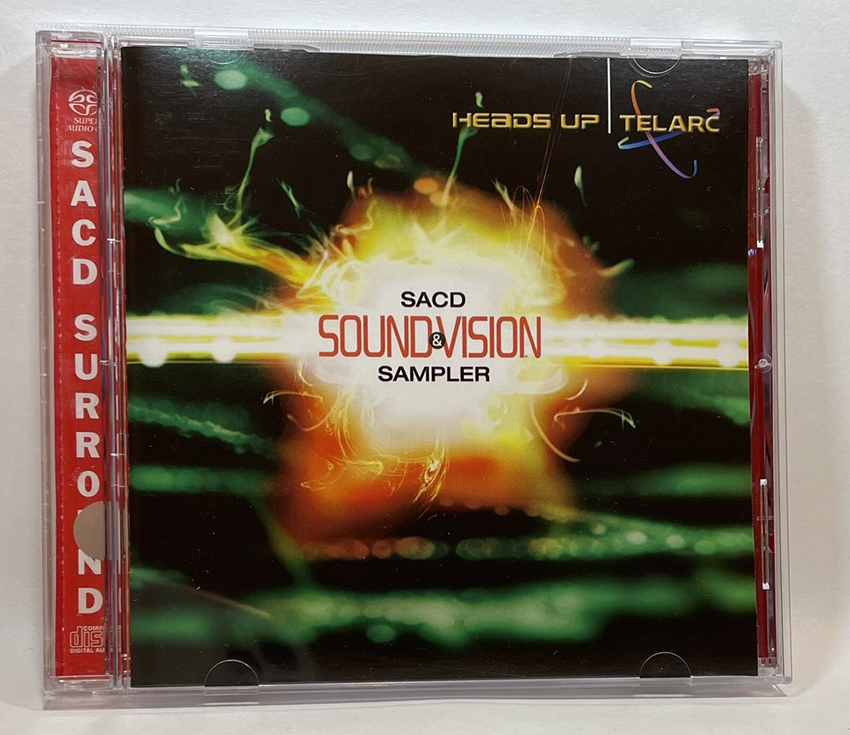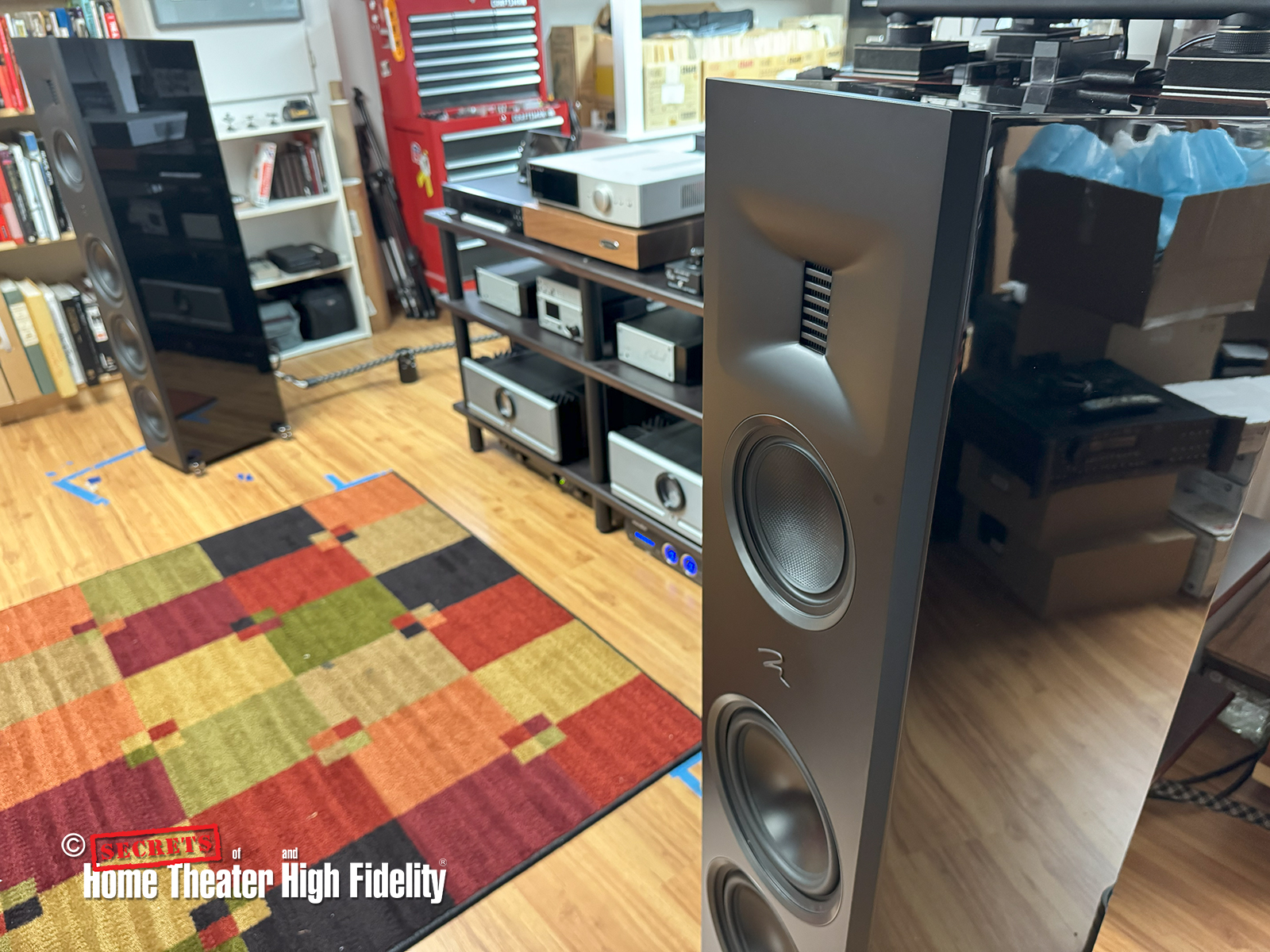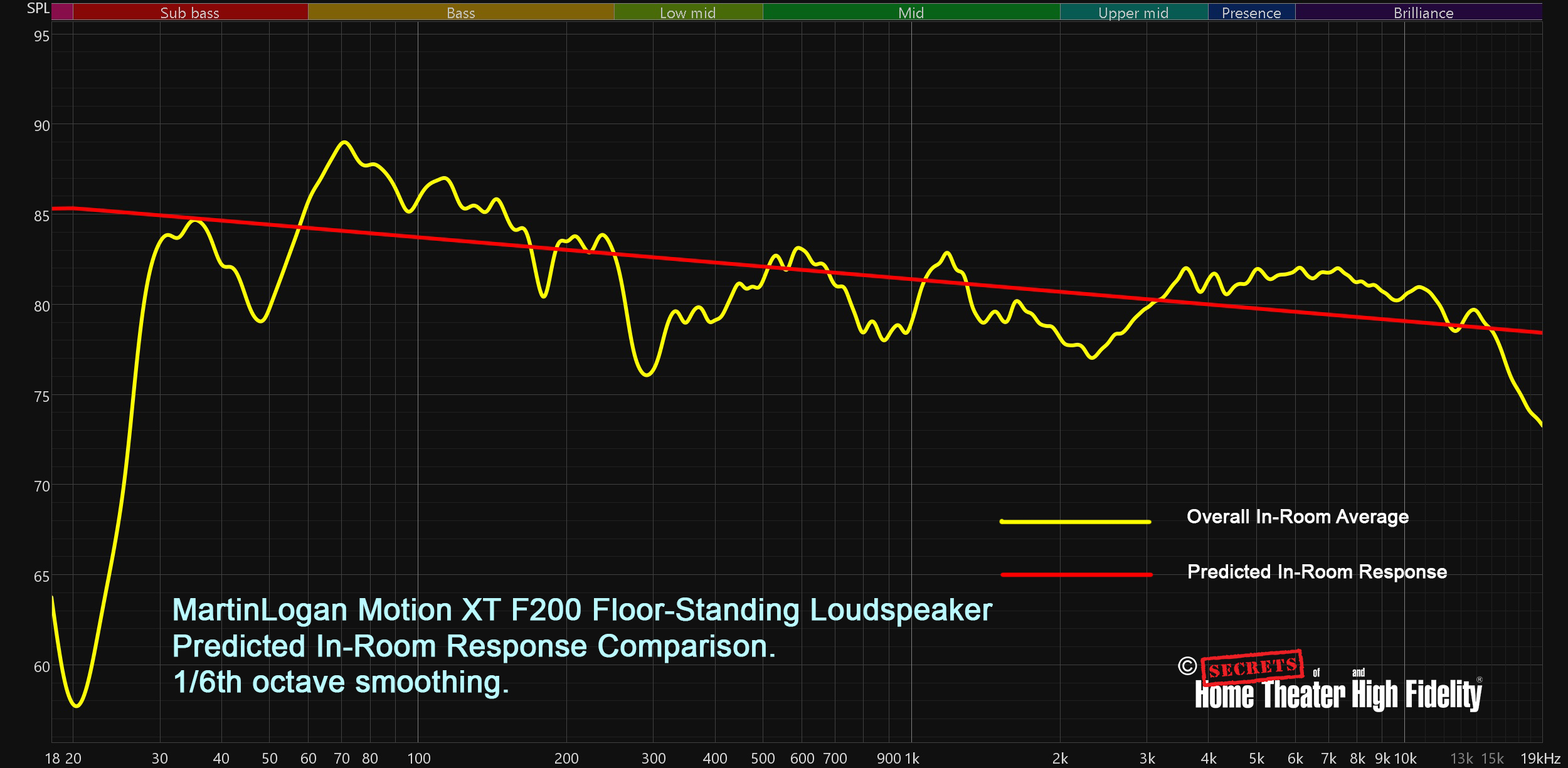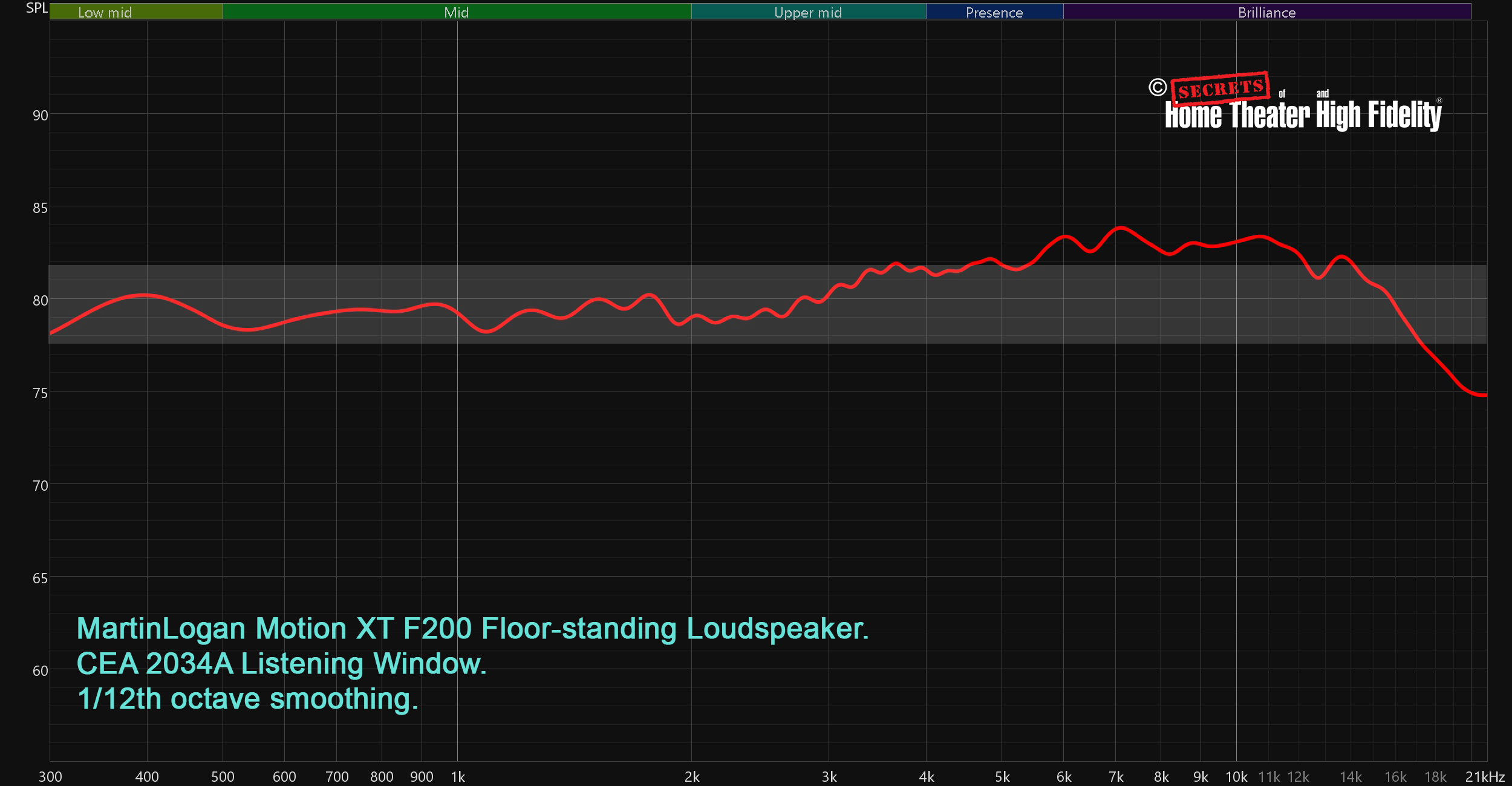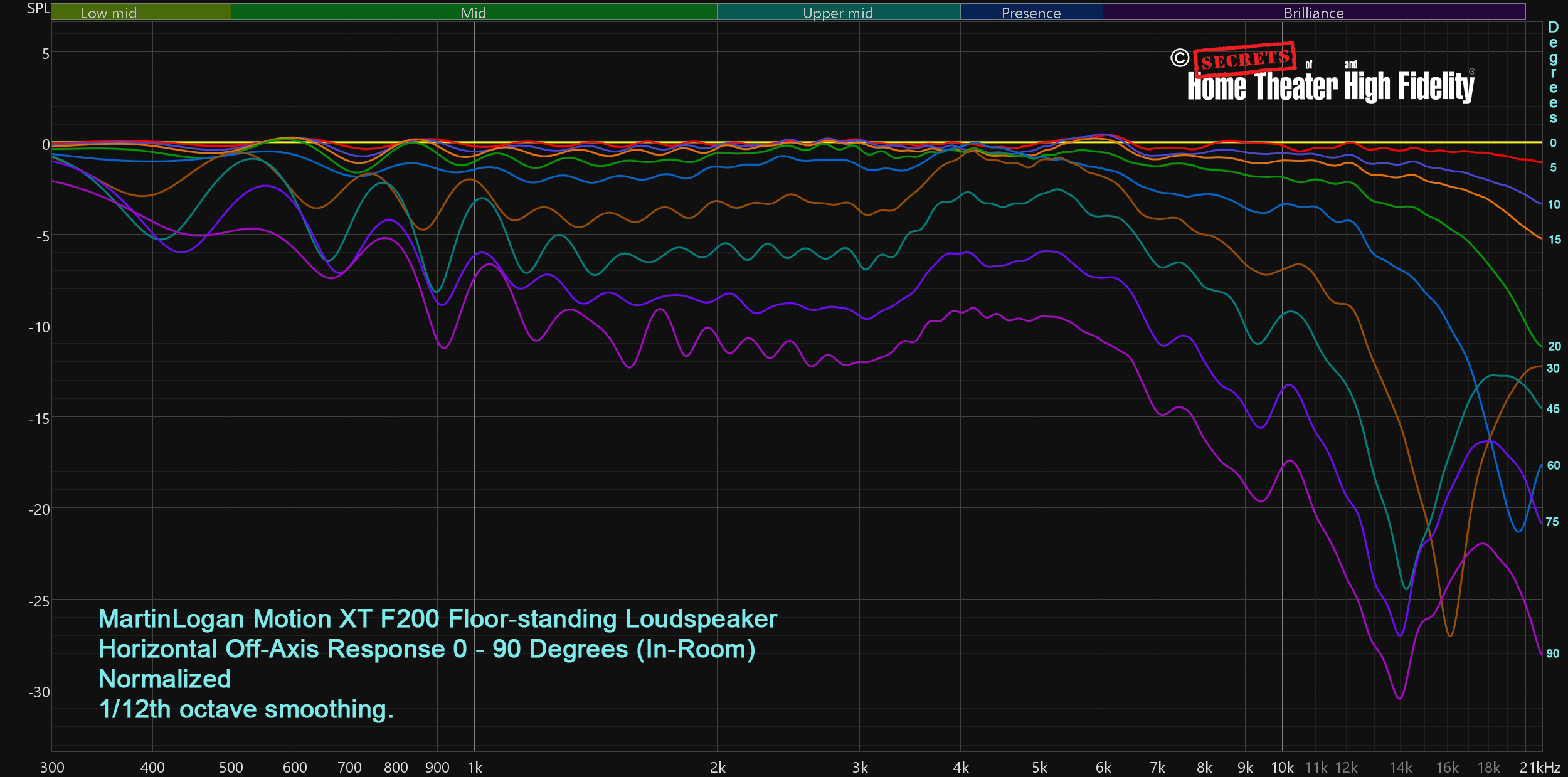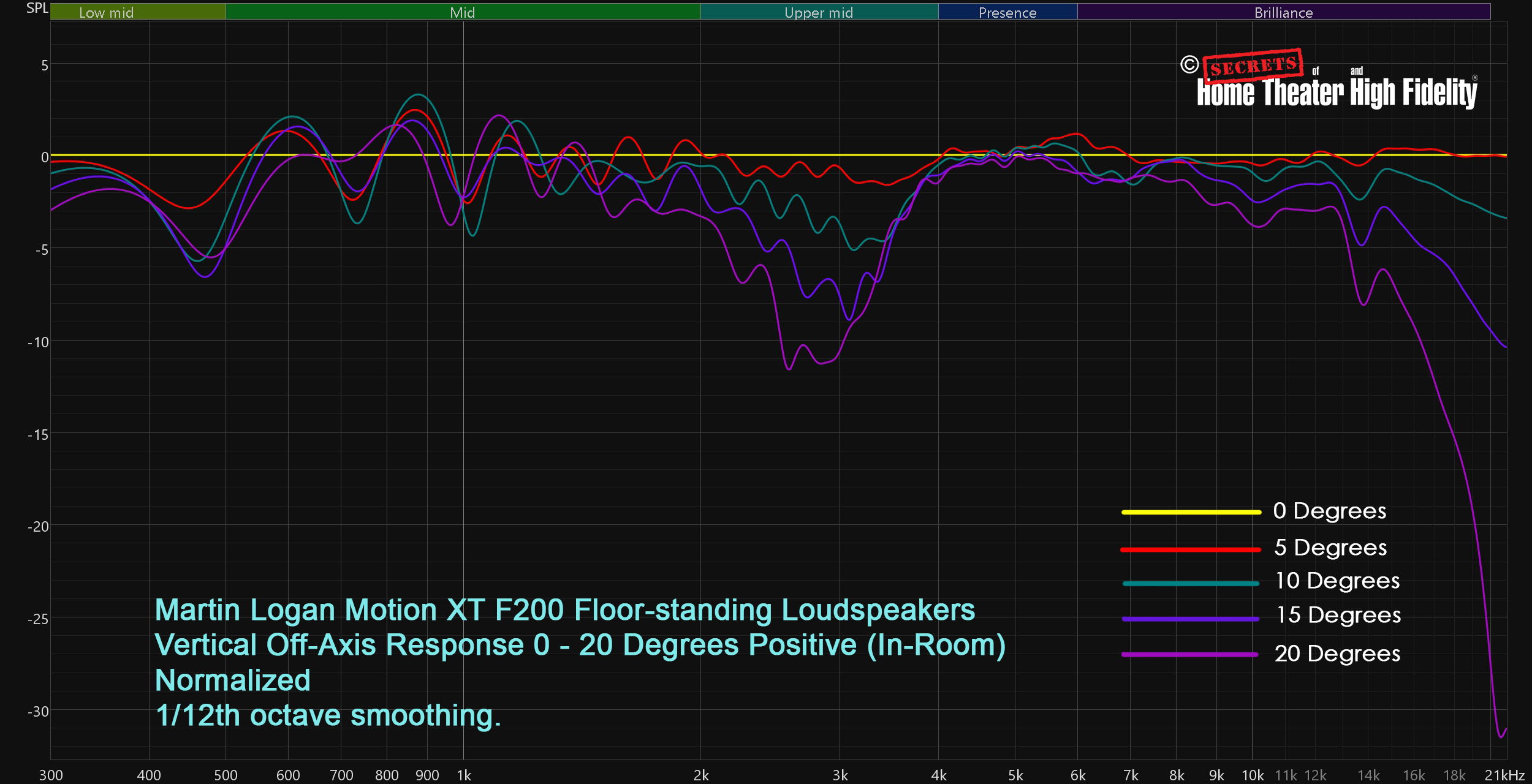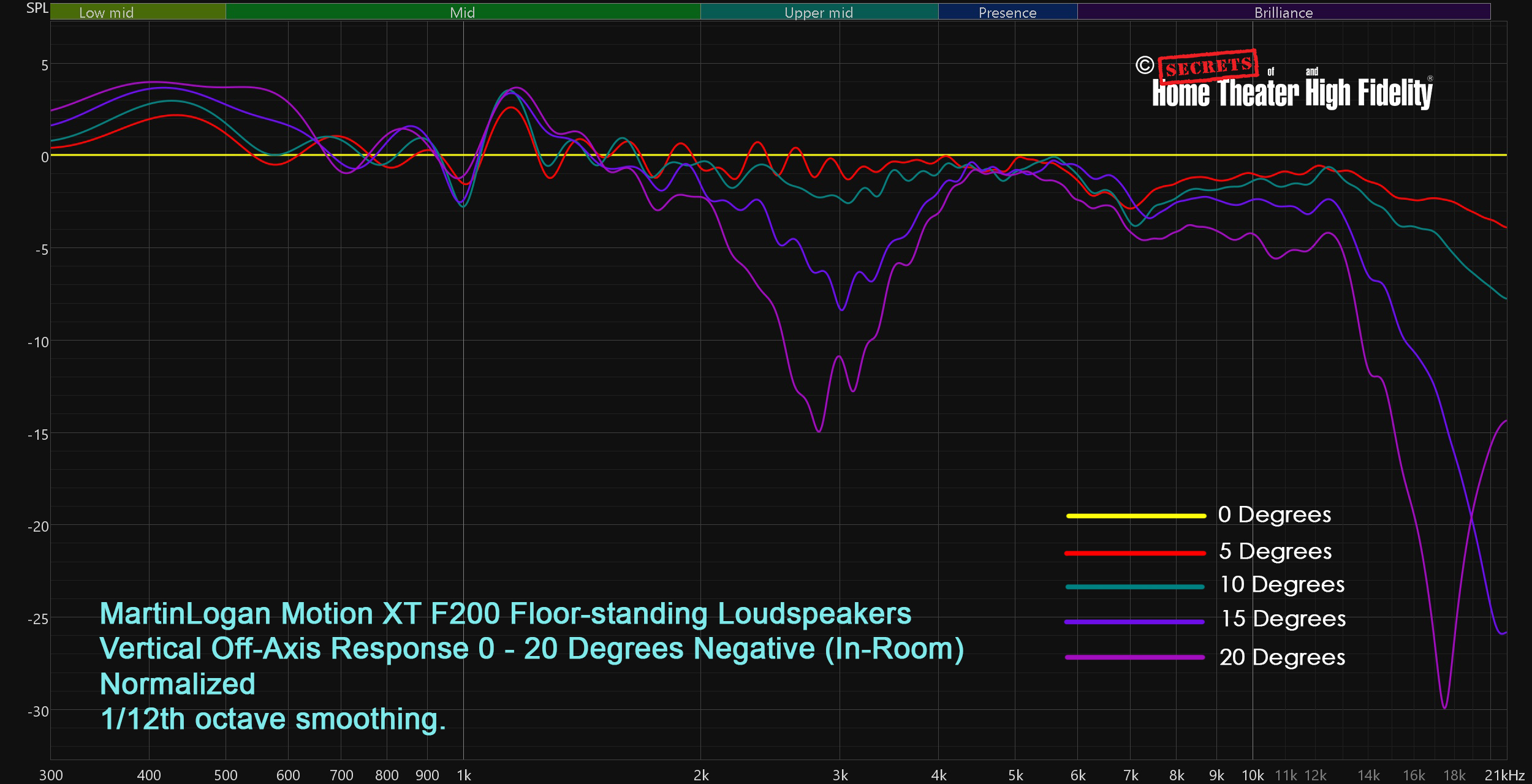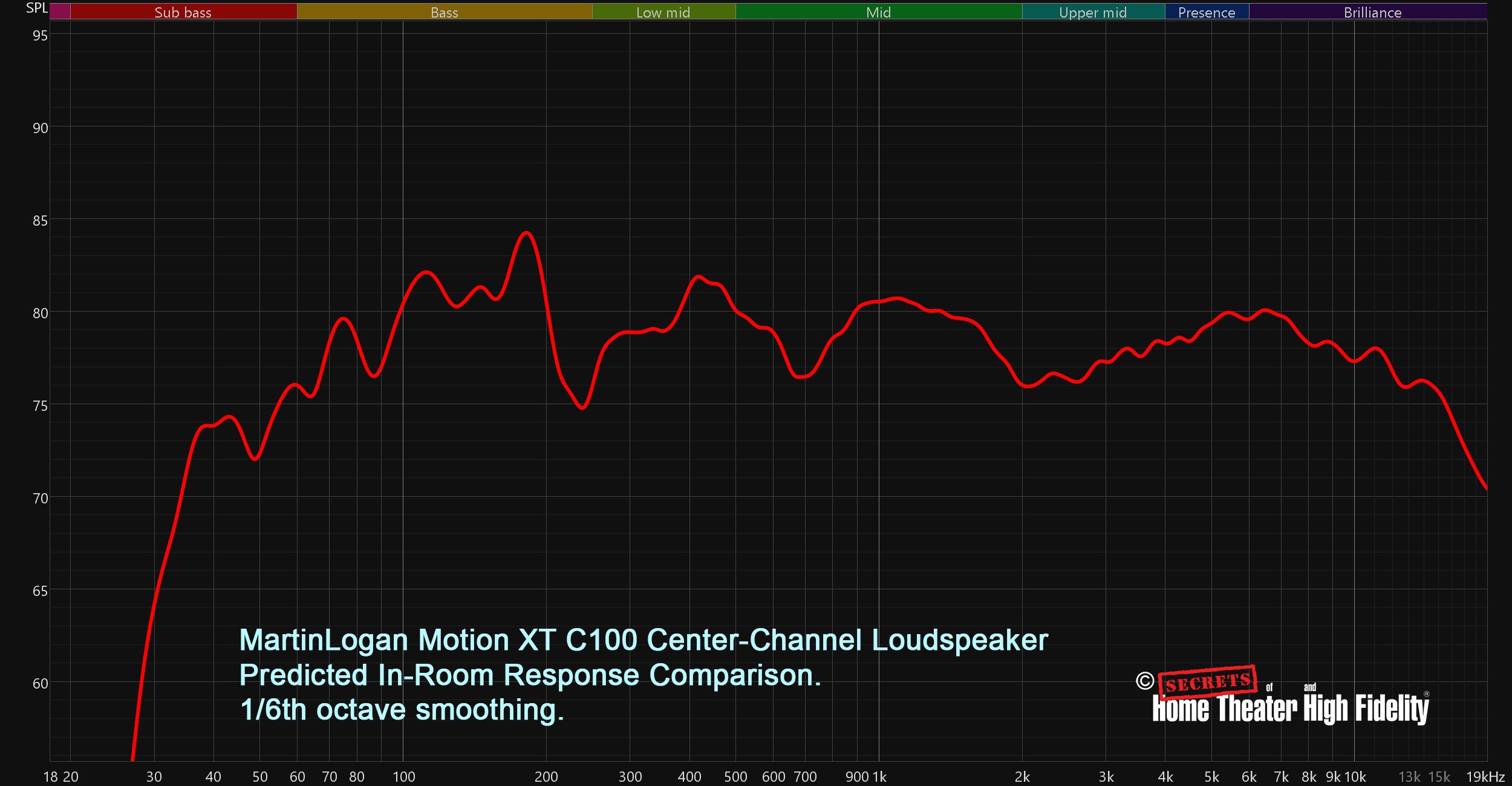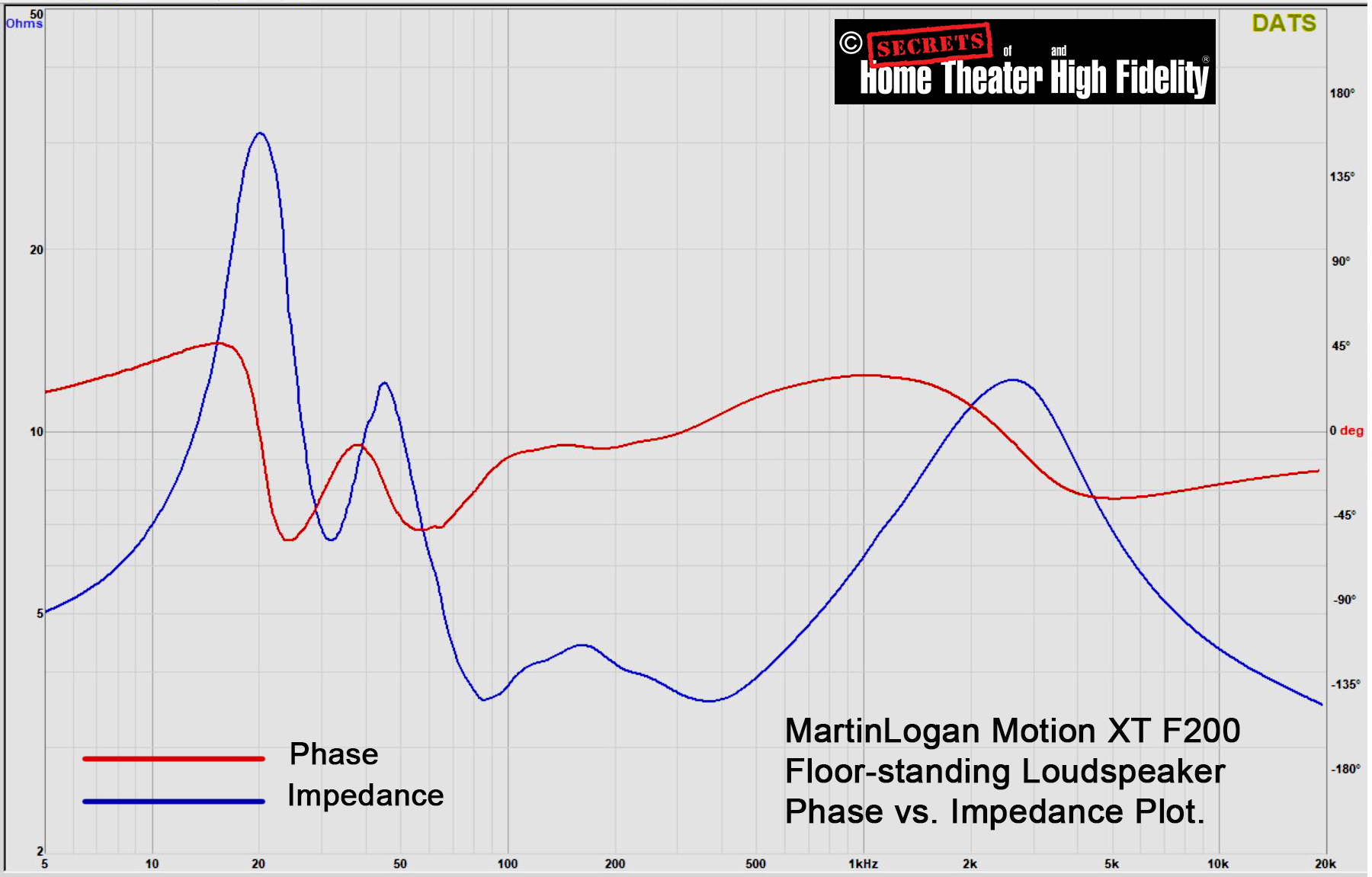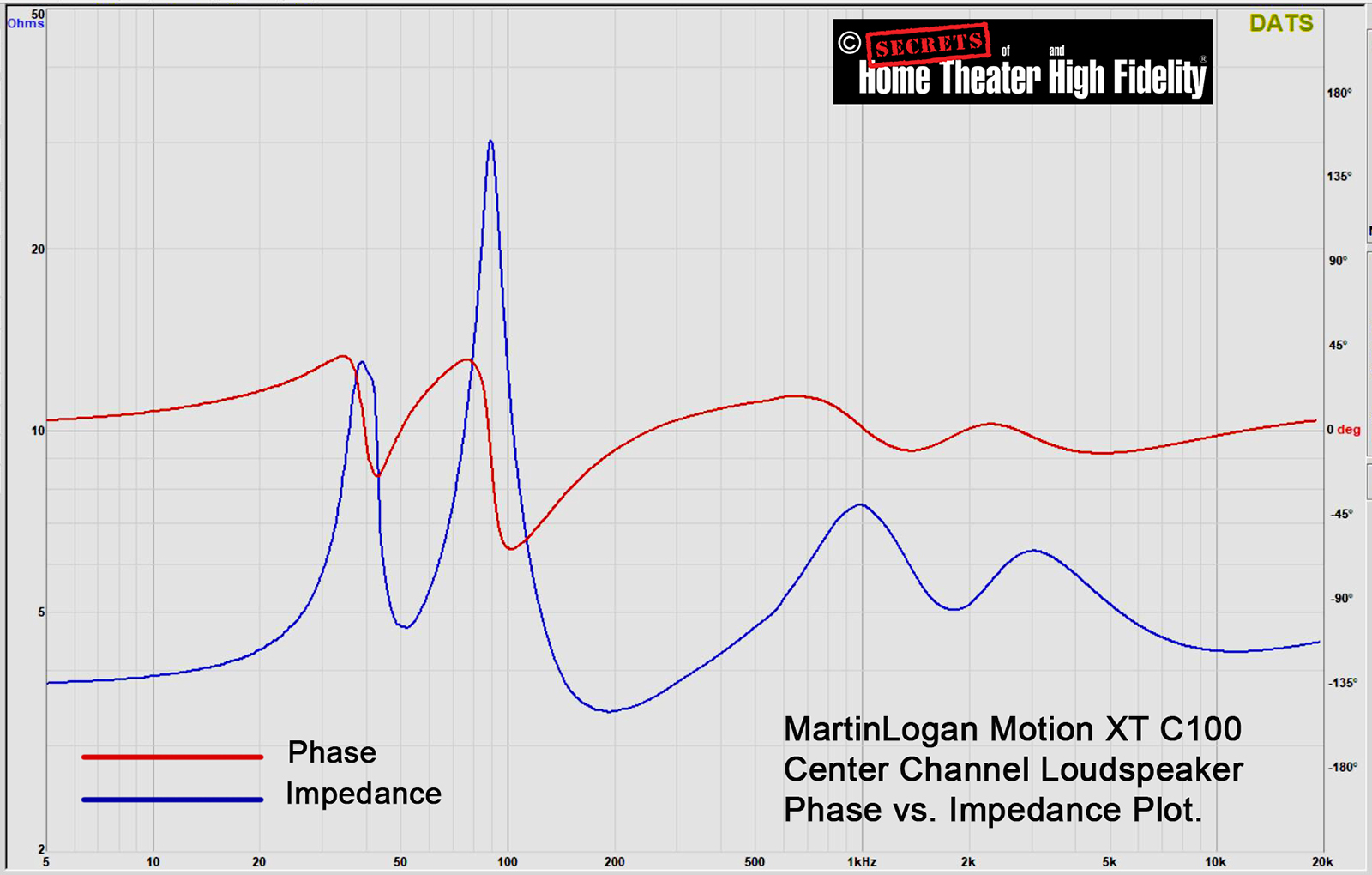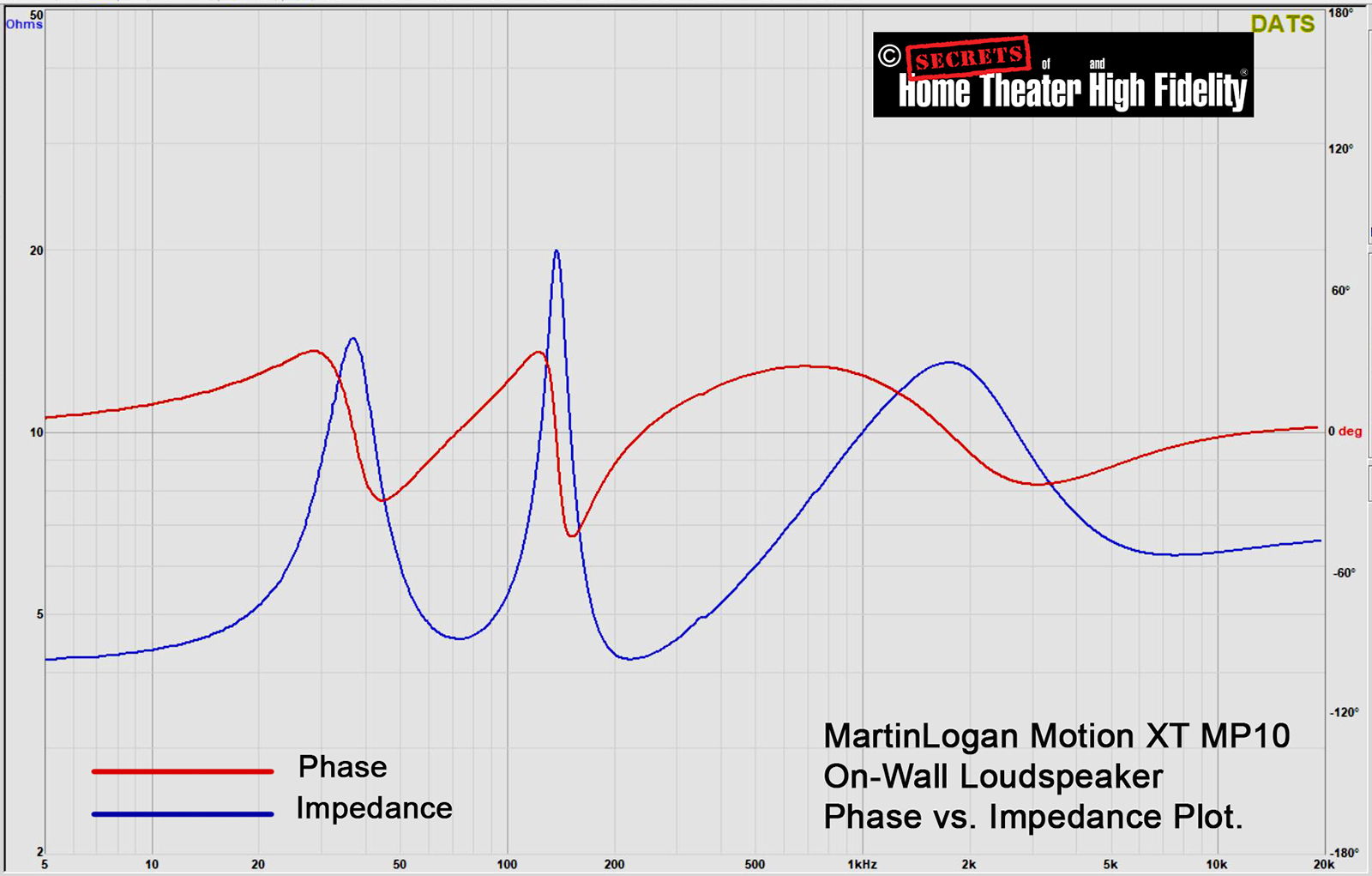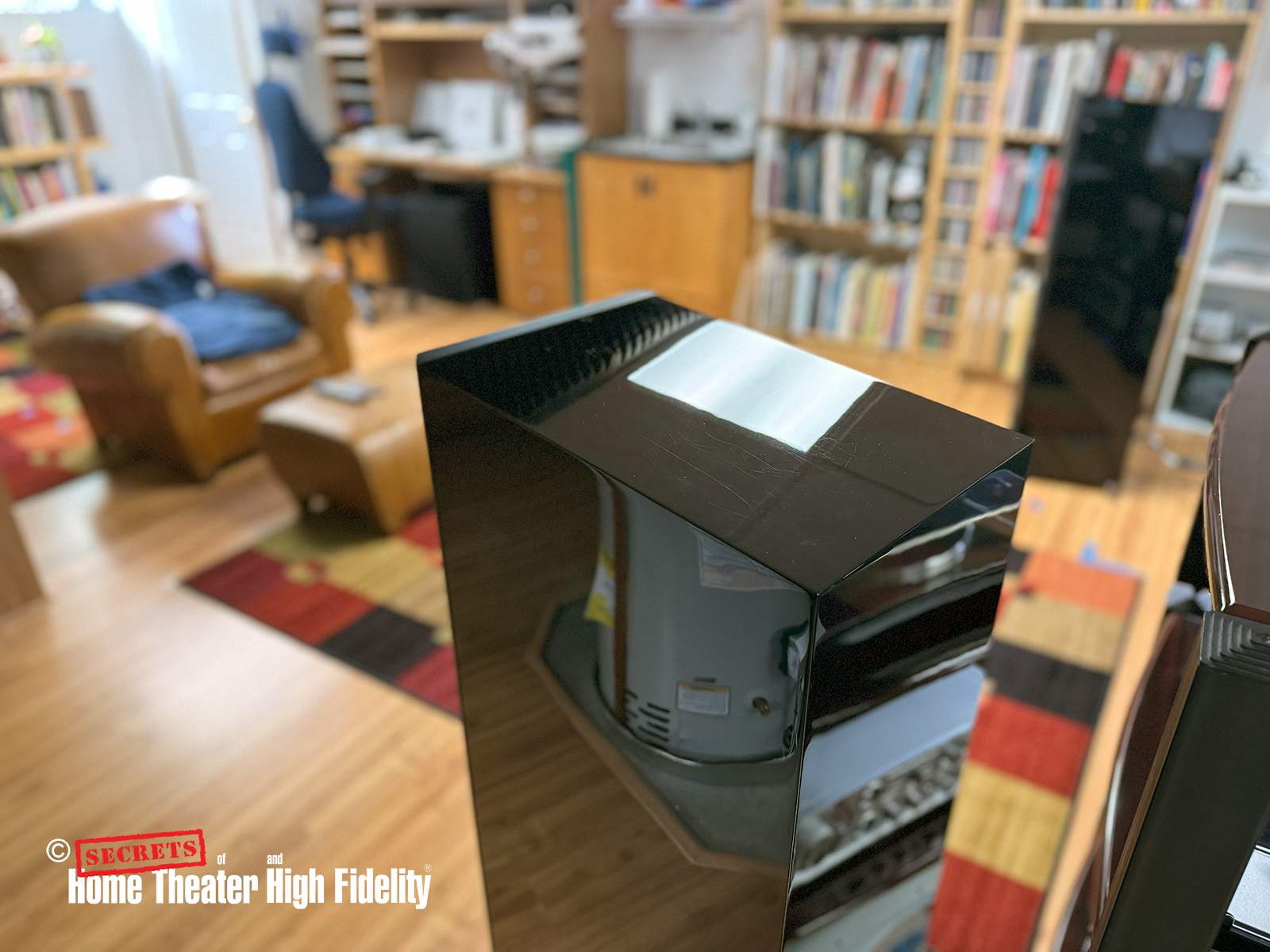The kind of experience that can only be produced by big electrostatic panels.
Surprise then! These dynamic driver loudspeakers are also from MartinLogan. They are the latest versions of MartinLogan’s Motion line, which originally launched in 2009 and was updated in 2014 and 2019. Getting a new top-to-bottom re-design recently, Motion now makes up three full product SKUs. The entry Motion Foundation series, the step-up Motion series, and the higher performance Motion XT series. What we have for review are the Motion XT F200 flagship loudspeakers, the Motion XT C100 center-channel loudspeaker, and a pair of Motion MP 10 on-wall surround loudspeakers for a full 5- channel MartinLogan home theater system.
MartinLogan Motion XT F200 Home Theater Speaker System
- The entire speaker package sounds cohesive and enveloping.
- The Motion XT C100 Center channel had surprising bass extension.
- Motion XT F200 towers and C100 Center have larger and more efficient 2nd-generation AMT-type tweeters.
- Both the tower and center use woven Nomex/Kevlar midrange drivers.
- The XT F200 is a big speaker with some serious bottom-end grunt.
- The C100 center has 2 different longitudinal sides, allowing the drivers to be angled at either 90 or 105 degrees.
- The MP10 surround speaker can be either wall-mounted flush or angled downward, depending on the need.
- The MP10 also has a stealthy rear port, allowing the speaker to reach lower than its size would suggest.
In case you weren’t aware, MartinLogan is owned by PML Sound, which also owns Paradigm and Anthem Electronics. This is why you’ll see the availability of Anthem’s ARC room correction in most MartinLogan subwoofers and even their flagship Hybrid Electrostatic speakers with powered woofer sections. In the case of the latest Motion series loudspeakers, the fine folks in Lawrence, Kansas, utilized Paradigm’s engineering facilities. Specifically, the anechoic chamber, in-house simulation software, and blind listening protocols to refine the voicing of the speakers. The result is a sound that is said to be different from prior Motion series products yet remains true to MartinLogan’s desired voicing. Why can’t more US/Canadian matchups be this fruitful?
In any event, I’ve been able to spend some quality time with this MartinLogan Motion XT ensemble in my home theater and using just the XT F200 tower speakers as a stereo pair in my studio 2-channel system. It’s been an interesting and enjoyable experience overall, and there is a lot to like about what we have here.
You’d be forgiven for wondering if there are design and sonic similarities between the MartinLogan Motion XT F200 towers and comparable models in the Paradigm Founder series. I wondered the same thing, and the short answer is “kind of, but not really.” Visually, there are similarities with the general cabinet shape and driver complement, but not necessarily the technical design, between the XT F200 and the Paradigm Founder 100F. They are also priced identically as well. But sonically, if my in-depth experience with the Paradigm Founder 120H was anything to go by, it has a noticeably different character. It seems quite clear that each speaker team had its own specific voicing and design targets. I suspect the XT F200 would appeal to those who like the sound of MartinLogan’s electrostatics but, for whatever reason, can’t accommodate those types of panel speakers.
But I am jumping ahead of things. Read on, and we’ll get into some more details about these impressive speakers.
Design:
3-way Bass-Reflex Floor-standing loudspeaker with bottom port.
Frequency Response:
27 Hz – 25 kHz ± 3 dB
Sensitivity (manufacturer):
92 dB
Nominal Impedance:
4 ohms
Crossover Frequency:
300Hz, 2600Hz (3-way)
High Frequency Driver:
Single 1.25” x 2.4” (3.2 x 6.1cm) Gen2 Obsidian
Folded Motion® XT Tweeter
Midrange Driver:
Single 6.5” (16.5cm) Nomex® Reinforced
Kevlar® cone with cast aluminum basket.
Bass Drivers:
Three 8” (20.3cm) aluminum cones with cast aluminum baskets.
Recommended Amplifier Power:
20 – 600 watts
Dimensions (H x W x D):
50-3/4″ x 13-3/4″ x 16-1/2″
128.9cm x 34.9cm x 41.9cm
Weight:
86 lbs. / 39kg
Available Finishes:
Gloss Black, Walnut, and Satin White
MSRP:
$2,749.99 each
Design:
2.5-way Bass-Reflex Center Channel loudspeaker with rear port.
Frequency Response:
42 Hz – 25 kHz ± 3 dB
Sensitivity (manufacturer):
93 dB
Nominal Impedance:
5 ohms
Crossover Frequency:
1,300 Hz, 2,500 Hz (2.5-way)
High Frequency Driver:
Single 1.25” x 2.4” (3.2 x 6.1cm) Gen2 Obsidian
Folded Motion® XT Tweeter
Mid-Bass Driver:
Dual 6.5” (16.5cm) Nomex® Reinforced
Kevlar® cone with cast aluminum basket.
Recommended Amplifier Power:
20 – 300 watts
Dimensions (H x W x D):
8” x 24” x 14-1/2”
20.3cm x 61cm x 36.8cm
Weight:
34 lbs. / 15.4kg
Available Finishes:
Gloss Black, Walnut, and Satin White
MSRP:
$1,499.99 each
Design:
2-way Bass-Reflex On-Wall loudspeaker with rear port.
Frequency Response:
81 Hz – 25 kHz ± 3 dB
Sensitivity (manufacturer):
92 dB
Nominal Impedance:
5 ohms
Crossover Frequency:
2,100 Hz (2-way)
High Frequency Driver:
Single 1” x 1.4” (2.6 x 3.6cm) Gen2 Obsidian
Folded Motion® Tweeter
Mid-Bass Driver:
Single 5.5” (14cm) Woven Fiberglass Cone with a cast polymer basket.
Recommended Amplifier Power:
20 – 200 watts
Dimensions (H x W x D):
14” x 8” x 5”
35.6cm x 20.3cm x 12.7cm
Weight:
9.7 lbs. / 4.4kg
Available Finishes:
Gloss Black, Walnut, and Satin White
MSRP:
$499.99 each
Website:
Company:
SECRETS Tags:
martinlogan, motion xt, folded motion, home theater, loudspeakers, amt
Secrets Sponsor
Starting with the Motion XT F200, we have a decently sized (almost 51” tall) “boxy” tower speaker with its tweeter centered at roughly 45” above the floor. It’s a classic 3-way design with twin ports venting out at the cabinet’s bottom. The tweeter is an AMT-style unit that MartinLogan calls the “Gen2 Obsidian FMT XT Tweeter.”
It is said to be upgraded with a larger surface area and a bigger driver motor over the previous generation unit. The tweeter is mounted within a custom waveguide (6” high x 8” wide) machined into the front baffle to help optimize the tweeter’s dispersion.
The 6.5” midrange driver has a cone that is composed of Kevlar® reinforced with Nomex that remains lightweight and controls any undue ringing or resonances throughout its bandwidth. The driver also features a heavy-duty cast aluminum basket and is treated to its own sealed enclosure space within the cabinet.
The three 8” bass drivers feature aluminum cones, also with cast aluminum baskets, and, as a trio, are positioned closer to the bottom of the cabinet to take advantage of the floor reinforcement of the bass frequencies.
The Motion XT F200 speakers are supported by four height-adjustable vibration-dampened feet attached to short outriggers. The feet can either have rubber or steel spike tips attached to them to accommodate carpeting or hard flooring. The rubber tips were the perfect solution for the hard laminate flooring of my studio space.
They also provide sufficient clearance for the previously mentioned dual down-firing ports. The porting scheme is said to allow more placement flexibility if the speakers need to be positioned closer to walls without adversely affecting the bass performance.
The back panel has two sets of 5-way speaker binding posts, allowing for either bi-amping or bi-wiring. I appreciated the generously sized “wingnut” style terminal screws. It made cinching down and disconnecting bare wire and spade connector speaker wire a breeze. It’s a nice little detail that shows up on all the Motion XT speakers. The speakers themselves are very large, glossy black boxes that won’t visually disappear into a room. While the optional Walnut or Satin White finish would certainly soften up their appearance, I do wish something a little more aesthetically interesting were done with the design of the enclosure.
The Motion XT C100 Center Channel is a 2.5-way design that uses the same tweeter with waveguide and two mid-woofer drivers (of a similar size and using similar cone material as the mids in the F200), arranged in a horizontal MTM configuration. I was curious to understand how the 2.5-way system worked in a speaker with a tweeter flanked by two identical mid-woofers. MartinLogan’s Product Manager, Andrew Lindsey, explained it to me thusly:
“In a 2.5-way MTM (Midrange/Tweeter/Midrange) configuration like C100, both woofers play the same up to the lower crossover point (1300 Hz), then one woofer rolls off and the other plays up to the tweeter crossover point (2500 Hz). This minimizes lobing effects in the same manner as a TM (Tweeter/Mid) design would, as near the tweeter crossover point, only 1 of the woofers is playing. Effectively, the C100 is an MTM design that plays like a TM design near the tweeter crossover point.”
The speaker cabinet’s long sides are designed so that, depending on which side you choose to rest the speaker on, the driver angles can be adjusted for standard center- speaker placement or a lower rack shelf placement. The speaker has a single large port in the back, offset from the dual sets of binding posts. The C100 also has a removable “ML” signature logo that can be oriented correctly for either placement option.
The Motion MP10 on-wall surround sound speaker uses a slightly smaller tweeter than the other speakers in a similar waveguide. The midrange driver is also smaller at 5.5 inches and has a woven fiberglass cone. The cabinet is designed in such a way that the MP10 can be oriented at two specific angles. Oriented with the tweeter above the mid/woofer, the MP10 flush-mounts to the wall and fires sound straight out. Flip the speaker 180 degrees, and it can be wall-mounted at a downward-facing angle, allowing sound to be directed at the listening position. It should be noted that I found the included wall mounting hardware for the MP10 to be well-designed, and it proved to be one of the more elegant and overall better solutions for this type of speaker mounting that I have come across. The speaker has a rather “stealthy” slot port in the rear that allows bass reinforcement regardless of the installation angle.
All the review sample speakers arrived with secure-fitting round grille disks for the various midrange and woofer drivers. I found this to be a nicer-looking alternative to a traditional full-length speaker grille, although I mostly kept them off. Each of the speakers arrived in a high-quality piano gloss black finish that looked very appealing when all were in place in my home theater.
Each of the speakers in this package is rated as a nominal 4-ohm load (the center channel and on-wall are 5-ohm), and all the sensitivity ratings are claimed as either 92 or 93 dB. If these specs are accurate, then my usual Anthem MRX 1120 AVR or the Denon AVR-A1H that is in for review should have no issues driving these speakers at normal listening levels. Lesser power receivers could prove insufficient for driving the MartinLogan speakers when dealing with dynamic multi-channel content.
As a complete surround system, I had the Motion XT F200, C100, and MP10 speakers set up in my 13.5’ x 18’ x 7.5’ home theater space, making up the main five-channel bed layer. Fleshing out the rest of the system were four GoldenEar SuperSat 3 speakers used for ATMOS height channels, and 4 sealed subwoofers (two front and two rear) configured as a square, each placed a quarter-width in from the nearest side wall. The subs are a Chase Home Theater CS 18.1 and an AV123 UFW-12HR in front, and two SVS SB16 Ultra subs in back. A Denon AVR-A1H home theater receiver was acting as the power and control backbone here, with Reavon UBR-X200 and OPPO BDP-103 Universal Disc Players acting as the main sources. An Apple TV 4K unit acted as the main content streaming hub. Room treatments are by GIK Acoustics, and cables were a mix of Viablue and Blue Jeans Cables.
I also evaluated the Motion XT F200 speakers as a set of full-range stereo speakers in my 2-channel studio setup. The associated equipment used for stereo evaluation consisted of:
– Two Pass Labs XA-60.8 Monoblock Power Amplifiers.
– Two Benchmark AHB2 Power Amplifiers.
– Benchmark DAC3 B Digital to Analog Converter.
– Benchmark HPA4 Preamplifier.
– Anthem STR Preamplifier.
– Anthem STR Power Amplifier.
– OPPO BDP-105D Universal Disc Player.
– GeerFab D.BOB Digital Breakout Box.
– DIY Raspberry Pi-based Endpoint.
– Technics SL1200 Mk6 Turntable modified by KAB Electroacoustics.
– Audio-Technica ART20 MC Phono Cartridge.
– TEAC PE-505 Fully Balanced Phono Preamp.
– Viablue Interconnect and Speaker Cables.
The speakers were positioned 9 feet apart and toed in very slightly, no more than 5 degrees. The seating position was 10 feet away from the center point between the speakers.
Starting with the whole speaker ensemble configured in my home theater, I found quite a lot to like about this upgraded Motion XT line. I began by running Audyssey MultEQ XT32 on the Denon AVR A1H using the AVR’s on-screen interface for a basic calibration to see if I liked what I heard with just the simplest one-and-done approach. And for the most part, the integration of all the speakers into a cohesive whole was very good, and the blend with my existing subwoofers was seamless. A surprise right off the bat was that Audyssey reported that the C100 Center Channel speaker exhibited usable output down to 32 Hz.
Most other similarly sized and configured Center Channel speakers, placed in the same spot on my entertainment stand, usually give up the ghost around 50 Hz or 40 Hz if they are on the bigger side.
Overall, I did feel like there was a slight dullness to the sound of the upper midrange on some familiar multichannel music tracks that I use for initial system evaluation and balancing. On a hunch, I opened up Audyssey’s MultiEQ-X Editor app on my laptop and reran a calibration on the system. Through the app, I was able to disable the “Midrange Compensation” (a preprogrammed 3.5 dB dip centered at 2 kHz) baked into the standard Audyssey calibration routine. That woke things up and brought back the extra life I was missing from the first run. Note to self, the computer app was worth the extra 20 bucks.

Top Gun 4K Ultra HD + Digital Code 2 Movie Collection DVD Set
Top Gun Maverick, like it or hate it, this movie has become a home theater demonstration staple due to its excellent ATMOS soundtrack, and honestly, I haven’t gotten tired of watching it yet. The C100 Center Channel speaker definitely stood out for delivering clear, clean dialog with good body to the vocals at all points in the film. From the focused, one-on-one moments between Tom Cruise and Jennifer Connelly to the action-packed moments as Cruise’s squadron is attacked by missile batteries after the successful bombing run during the last act of the film. There is so much happening in the way of missiles, flares, explosions, dialogue, music, and effects during this sequence, and the Motion XT C100 keeps it all clear and sorted.
Bringing in the big F200 towers and the MP10 surrounds into the discussion, the overall sonic envelopment was rather impressive and immensely enjoyable. Aircraft, missiles, and the aerial countermeasures that tracked from side to side, back to front, and across and over were all achieved cohesively and with plenty of detail, without sounding irritating in any way. Audyssey’s Reference tuning curve by default employs a bit of a top-end roll off to take the edge off movie soundtracks (this can be tweaked via the app, or a Flat tuning curve can be chosen in the AVR menu), and with some speakers, this can make them sound overly soft in the treble. I did not experience that sense with the MartinLogan Motion ensemble. As it was, I found the top end in particular to sound very much to my liking. Nothing sounded overly harsh or soft in the upper frequencies, and the whole experience was very appealing.
Switching to multi-channel music in the home theater, Sound & Vision may no longer be an A/V review print publication, but one of the best things they ever did was offer this multi-channel SACD music sampler disc curated from the Telarc Records label’s 5.1 channel music library. While long out of production (2006), I find it an invaluable tool for dialing in and balancing a surround sound system. It has 15 tracks of wonderfully recorded multi-channel jazz, blues, New Age, and vocal music that are very revealing of both good and not-so-good systems. The track, “Don’t Ever Let Nobody Drag Your Spirit Down,” is a slower blues tune featuring Eric Bibb, Rory Block, and Maria Muldaur, and the MartinLogan Motion XT system made me feel like I was sitting in the center of the recording session. The overall sense of envelopment was excellent, yet the specific and detailed instrument cues came through clearly, such as Bibb’s acoustic guitar in the front left and center channels, the piano in the front right, and the drum cymbals resonating through the surround channels. Bibb’s guitar had plenty of detail revealed on its strings, and the sheen on those cymbals sounded nicely metallic too. Bibb’s vocals can also sound slightly thin if the center channel speaker is not quite as capable in the lower midrange and upper bass region. There is no issue in that regard with the C100 center speaker, as his voice had the right sense of body and weight to it throughout. The MP10 surrounds also did a very nice job with the ladies’ voices, harmonizing in the background behind me, giving them a solid, integrated presence.
Speaking of female voices, Jazz vocalist Tierney Sutton’s rendition of “I’ve Grown Accustomed to His Face” is a great litmus of surround envelopment and a bit of a midrange driver torture test. Starting with a bit of ethereal vocalizing in the surround channels that increases in intensity as it transitions to the front left and right channels and eventually to the center channel. The pitch of her notes has, in some instances, revealed poorly damped driver cones or improperly mounted drivers through nasty buzzes and resonances. The MartinLogan XT speakers handled it all with a smooth and deft touch, as I felt her voice slowly travel from back to front, where the drums, piano, and bass joined in to complete the ensemble. And it didn’t seem like just any old plain voice that was moving, but more like a reverberant vocal wavefront with palpable mass that I felt shift through the whole room. I could cite plenty of other wonderful examples from this disc, but suffice it to say that as a full system package, the MartinLogan Motion XT series can more than deliver a memorable performance with both movies and multi-channel music.
I was also curious to evaluate the Motion XT F200 tower speakers on their own in a simple stereo setup. After having them moved and positioned in my studio space, I quickly discovered that they had a definite personality of their own. For a change, I experimented with some different positioning that had the big F200 speakers placed much closer to a back wall than I normally do. For these speakers, I found that their prodigious bass output started to bloat and muddy up the upper bass area noticeably. As soon as I pulled them out, past 3 feet into the room, that muddiness completely disappeared. Every room is different, so your experience may vary. But that is what seemed to work for me.

Brian Bromberg with Tom Zink & Charles Ruggiero, “LaFaro”
While sitting in my standard office chair, which puts my ears 44 inches off the floor, the upper midrange and treble reproduction of these speakers has noticeably more sparkle to their presentation. Unlike the similarly sized Paradigm Founder 120h speakers that I had here a while back. In this same room, the Paradigms had a more linear and comparatively restrained top end. Switching chairs to something that put my ears 39 inches off the floor, the top end softened a little bit, where the Paradigms stayed roughly the same. I split my time listening from both chair heights to get a better sense of the overall sound. No doubt, these MartinLogans are “airier” at the top, as I experienced when listening to Brian Bromberg’s take on the track “Waltz for Debby” from his recent album, LaFaro.
The opening high-hat cymbal strikes had a livelier sheen and sound that I am used to, as did the gentle upper register piano notes that came in right behind the cymbals. Both had an effortless quality to them that I found appealing to listen to. As the piano notes moved into the mid-band, they maintained a nice body and weight to their sound and eventual decay. But this wouldn’t be Brian Bromberg if we didn’t discuss the acoustic bass playing, which was sublime. The Motion XT F200 can certainly “kick” when it comes to bass, and while they don’t have the active bass section of the sister Paradigm speakers I reviewed, the triple 8-inch bass drivers with bottom ports provided an excellent level of tight, deep bass extension even as I had them placed well away from the rear wall. Each of Bromberg’s plucks on his bass was relayed not just with excellent depth, but detail, and clarity too.
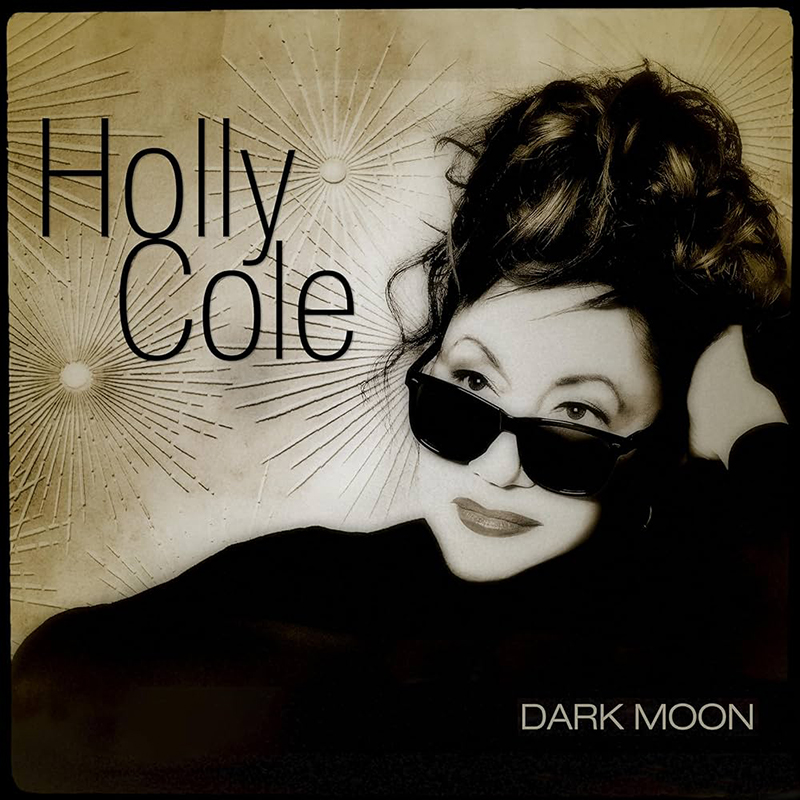
Holly Cole, “Dark Moon”
Switching to vocals, “Where Flamingoes Fly” from Holly Cole’s latest album Dark Moon is a wonderfully intimate and beautiful track. The Motion XT F200, when left to its own devices, will throw a very wide and expansive image, and both the bass and piano on this track made a big enveloping semi-circle of sound. Just like on the Brian Bromberg track, the acoustic bass here sounded deep and impactful, and the string detail from the plucking was easily communicated by these speakers. All the while, Holly Cole’s voice was pegged smack in the center, with a warm and inviting character that drew me into her song. The close recording of Cole’s voice gave plenty of material for the F200 speakers’ midrange drivers to work their magic. I consider Holly Cole one of the best and most unique vocalists ever, and how she uses her voice in her craft is pure artwork. These MartinLogans let me enjoy every nuance of her singing, and I felt like I was practically there, sitting in on the recording session. The speakers’ “airier” upper-end presentation gave me a little bit of the sense of listening to electrostatic speakers, but with a wider sweet spot for better off-axis listening. Beautiful, beautiful stuff.

Leo Kottke, “Standing In My Shoes”
Moving to some acoustic guitar, I cued up Leo Kottke’s “Standing In My Shoes” from the album of the same name. Kottke’s brilliant and unorthodox fingerstyle technique on guitar comes through with precision via the XT F200 speakers. Both the air and detail of the lighter strings and the weight and resonance of the lower strings come through equally well. There is, as best as I can describe it, a metallic “zipper” kind of sound Kottke gets as he moves the slide quickly across the strings. It has a unique sound, and the XT F200’s tweeter and midrange combination seems to nail the tone, grit, and sense of speed to it. Leo Kottke’s baritone, and somewhat deadpan, voice was perfectly centered and had a nice resonant weight to it, while the female background vocals are nicely spread out to the extended left and right edges of the speakers. The languorous bassline was deep and easy to follow, nicely underpinning the whole song. Some string harmonics occasionally punctuate the song that seemed to appear and extend above and outside the speaker’s boundaries. Again, as a stereo pair, the Motion XT F200 excelled with these tracks.
As a point of interest, all the amplifiers I used had no problem driving the MartinLogan XT F200 speakers. If someone pressed me for my favorite pairings of the equipment I had on hand, it would be a tie between the Anthem STR preamp and STR amp combo and the Benchmark HPA4 preamp paired with the two Pass Labs XA 60.8 monoblocks. Each had more than enough power (those Pass Labs amps have to be very conservatively rated). The Anthem combo was transparent and clean, while the Benchmark/Pass combo was “MAYBE” a little more musical. Regardless, either setup was a winner.
Bench tests were performed with a Cross-Spectrum Labs calibrated UMIK-2 microphone connected to my computer workstation using Room EQ Wizard acoustic measurement software. All near-field measurements were made with the microphone tip centered between the tweeter and midrange drivers at a 1-meter distance from the speaker, with the test speaker positioned as far away from any walls as possible. The In-room average response measurements are derived from an 18-point spatial average taken from around the listening position (about 11 feet away), with the microphone capsule placed 44 inches off the ground.
Caveats: Unlike measurements taken outdoors or in an anechoic chamber that measures a speaker in isolation, in-room measurements give a sense of how a speaker behaves in the actual environment in which it’s used. Both types of measurements are valuable (make no mistake, a properly designed speaker in an anechoic environment will hold up much better in an average listening space), I just find in-room measurements interesting as they help shed light on what I am hearing and why. Note that no in-room measurement will ever match an anechoic measurement, and a measurement taken in my room won’t necessarily match a similarly done measurement taken in your room. But, after measuring dozens of speakers here, I’ve acquired a good understanding of how this space interacts with the speakers, and some general performance observations can always be drawn.
This in-room measurement of the MartinLogan Motion XT F200 tower speakers is an 18-point spatial average. A 9-point measurement was made for the right speaker and then repeated for the left speaker. Averaging both speakers is an approach others have been using and publishing. Using data from both speakers reduces the modal response of the room by averaging the differences in the response of the two speakers from room asymmetries. The technique cannot eliminate them, however, and so the response below 300Hz remains room dominated.
David Rich notes:
From 1 kHz to 10 kHz, we see the “smiley-face” voicing (around the midrange-tweeter crossover point) coupled with the tweeter amplitude moved up in level. At the bottom end, the excess energy is identified between 50 Hz and 100 Hz, although this will be room dependent. The dip in the 700 Hz—800 Hz region appears to be a room issue. It is not in the quasi-anechoic listening window shown below.
This is a plot of the NRC listening window for the MartinLogan Motion XT F200, scaled from 300 Hz on up, which is averaged from the following measurements: 0-degree on-axis, +/-15-degrees vertical, and +/-15-degrees horizontal. This is the portion of the frequency range that is dominated by the speaker (response below 300 Hz tends to be dominated by the room and can vary greatly).
David Rich notes:
A small amplitude dip at the crossover is followed by a significant (4 dB) tweeter push. The midrange is flat from 300 Hz to the crossover. Ripples in the tweeter may be related to the protective horizontal slats covering the tweeter.
This is a plot of the CEA-2034A listening window for the MartinLogan Motion XT F200, scaled from 300 Hz on up, which is averaged from the following measurements: 0-degree on-axis, +/-10-degrees vertical, +/-10-degrees, and +/-20-degrees horizontal. This is the portion of the frequency range that is dominated by the speaker (response below 300 Hz tends to be dominated by the room and can vary greatly).
David Rich notes:
The CEA curve is taken with a reduced vertical displacement of the microphone and more measurements in the horizontal plane. As we will see below, the midrange—tweeter crossover is very sensitive to vertical microphone placement changes. Thus, we see a bigger dip in the crossover area in this curve compared to the NRC curve.
Above are the normalized horizontal radiation curves of the MartinLogan Motion XT F200 from 0 to 90 degrees, scaled from 300 Hz on up, measured in-room in the near field.
David Rich notes:
This is an odd-looking curve. As we will see from the vertical radiation pattern, the crossover is at 2.6 kHz, yet here, the speaker has constant directivity with a frequency of 1 kHz – 3 kHz. A cone speaker would typically show a roll-off with frequency and then snap back at the crossover to the tweeter unless a waveguide was used.
Here, the snapback is 3.5 kHz – 5 kHz. It’s not ideal to see a snapback here, and I don’t understand why it is displaced by 1 kHz.
Moving to the vertical radiation pattern for positive angles. We see the plots of 0 to +20 degrees, scaled from 300 Hz on up, measured in-room in the near field.
Here we have the vertical radiation pattern for negative angles. We see the plots of 0 to -20 degrees, scaled from 300 Hz on up, measured in-room in the near field.
This is an overall In-Room Average measurement of the MartinLogan C100 Center Channel speaker done in the same studio space as the F200. You can see that the speaker has solid output down to 40 Hz, and this is with the speaker situated on a speaker stand well off the floor. Placed on an entertainment center and with the additional room gain from being closer to a wall, getting solid output from this speaker into the low 30 Hz range would not be unexpected.
Here we have the Impedance sweep for the MartinLogan Motion XT F200. The results show that the speaker remains below 6 Ohms from 5 Hz to 8 Hz, from 60 Hz to 1 kHz, and from 6 kHz to 20 kHz. There are peaks as high as 32 ohms at 20 Hz and 13 Ohms at 45 Hz, and 2.5 kHz. From 60 Hz to 1 kHz, and everything past 6 kHz is below 6 Ohms. Between 75 Hz to 500 Hz, the speaker’s impedance hangs at roughly 4 Ohms. The Motion XT F200 specifications rate its nominal impedance as 4 ohms, which looks accurate.
Here we have the Impedance sweep for the MartinLogan Motion XT C100 Center Channel. The manufacturer rates this speaker as a nominal 5-Ohm load, and the impedance sweep shows that the C100 only drops to 4-Ohm territory below 20 Hz and between 150 Hz to 350 Hz. The 5-Ohm rating is accurate.
Here we have the Impedance sweep for the MartinLogan Motion XT MP10 On-Wall Surround speaker. Like the C100, the manufacturer rates this speaker as a nominal 5-Ohm load, and the impedance sweep shows that the MP10 only ever gets close to 4-Ohm territory below 15 Hz and between 175 Hz to 300 Hz. The 5-Ohm rating is accurate.
Secrets Sponsor
The MartinLogan Motion XT series of loudspeakers is a sonically desirable and satisfying option for both movies and music. Definitely worth your time and consideration if a speaker purchase is on the horizon.
- Seamless, balanced, and enveloping sound for home theater use.
- The XT F200 towers produce effortless top-end extension with serious low-end punch.
- Several intelligent design touches make the Motion XT system a pleasure to use.
- Vocals, in particular, sounded very appealing, both in surround and stereo.
- Something a little more aesthetically appealing for the design of the towers.
This updated MartinLogan Motion XT speaker package creates an excellent and immersive home theater and multi-channel music listening experience. In my case, they created a seamless, sonically matched 5-channel core layer that meshed superbly with my existing height channels and subwoofers. The newly refined Folded Motion Tweeter and midrange drivers never came across as overly bright-sounding. I found the combination to be quick, detailed, and nicely balanced overall.
At no point in my home theater listening did I feel that the speakers were compressing the sound or that the Denon AVR-A1H I was using was running out of steam, but I would definitely recommend a higher-power AVR or an external multichannel amplifier to get the most out of this package. You might also consider the smaller XT F100 towers for the Left and Right channels if you don’t have the space/power for the bigger F200 or even the B100 bookshelf speakers on stands if your space is smaller.
As a stereo pair of speakers, the Motion XT F200 was very satisfying to listen to. Properly positioned, they produced solid, deep bass in abundance, but without it overshadowing the mids and the highs. There is a bit more treble energy and presence in these big MartinLogans, so you may have to adjust your seating height to get your preferred result. In my listening, it didn’t ever come across as overly bright or fatiguing, but my personal preference was to sit at a slightly lower position. Whatever way the engineers have designed and tuned that Folded Motion Tweeter driver, it results in a sense of lightness and transparency in the upper frequencies that I ultimately enjoyed. Again, be aware that the F200 are big speakers, and you should have the appropriate space if you are considering them.
Overall, whether for surround sound or stereo use, these updated MartinLogan Motion XT loudspeakers are definitely worth considering, as they left a big smile on my face. Recommended.
The author wishes to thank David A. Rich for his invaluable assistance with this review.



